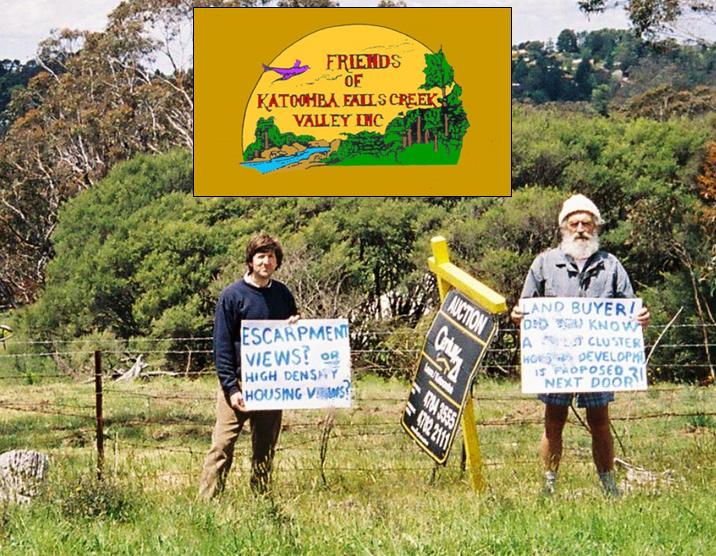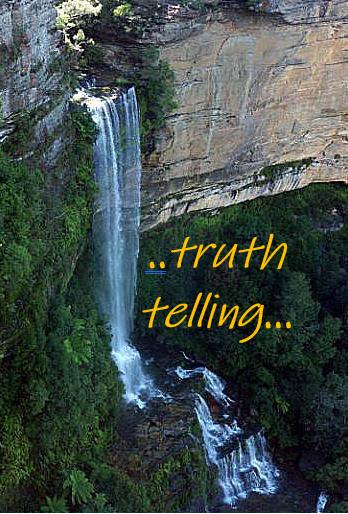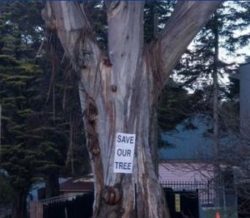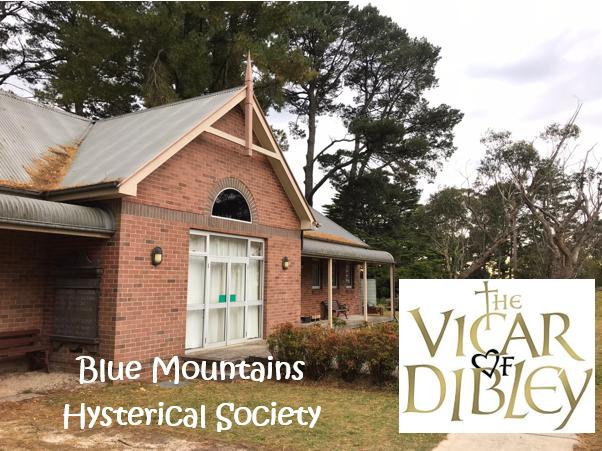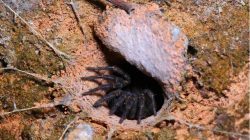Posts Tagged ‘Coal Mining’
Sunday, November 11th, 2012
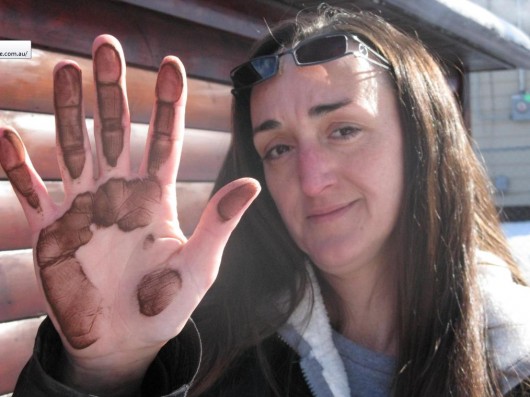 Lessons from coal mining destruction of the Appalachian Mountains and its people Lessons from coal mining destruction of the Appalachian Mountains and its people
2010 West Virginia, United States of America
.
<<Maria Gunnoe is a community member and organizer for the Ohio Valley Environmental Coalition. Here, she displays the coal dust wiped from Frankie Mooney’s garage in Twilight, West Virginia. The nearby blasting routinely fills the air with coal dust clouds, which then settle on buildings and turn air filters black. If Massey had its way, Twilight would become the next Lindytown – but Frankie’s property is closest to the company land and his refusal to sell protects the rest of Twilight from destruction.>>
[Source: ‘Stand with Coalfield Residents at Appalachia Rising‘, by ‘Carolyna’, 20100917, ^http://members.greenpeace.org/blog/carolyna/]
.
‘New report highlights health fears for Hunter Valley’
[New South Wales, Australia]
[Source: ‘New report highlights health fears for Hunter Valley’, 20121029, Australian Broadcasting Corporation, ^http://www.abc.net.au/news/2012-10-29/new-report-highlights-health-fears-for-hunter-valley/4338446]
.
 A Dickensian Industry
[Source: The 2012 London Olympics, ^http://www.mirror.co.uk/news/uk-news/london-2012-opening-ceremony-opinion-1176668] A Dickensian Industry
[Source: The 2012 London Olympics, ^http://www.mirror.co.uk/news/uk-news/london-2012-opening-ceremony-opinion-1176668]
.
<<Health authorities are coming under pressure to properly investigate the health impacts of mining on Australia’s largest coal mining region, in the New South Wales Hunter Valley.
It comes after new research showing a link with increased death rates and disease in some other countries.
Sydney University’s Associate Professor Ruth Colagiuri analysed research from 10 countries including the USA and the UK. She says coal mining communities there had elevated rates of cancer and higher death rates from illnesses such as heart, lung and kidney disease. Birth defects were also more prevalent.
 Deadly Coal Dust Deadly Coal Dust
.
Professor Colagiuri:
- There are clear indications of serious health issues associated with coal mining and coal-fired power plants for surrounding communities. But.. there has been no such research done in the Hunter Valley.
- We have very little in Australia on the health harms at all. I guess until we have our own studies we don’t know for sure but it would be silly to think that some of the evidence is not applicable here, particularly if it’s not from the countries that are more applicable to Australia, culturally and economically.
- It is time to gather the evidence, so (that) judgments can be made…about whether the harms we’re finding in the international literature do apply to Australia.
.
The Cancer Council’s head Ian Oliver agrees: “The people who live in these areas need to be aware of whether the same thing applies here,” he said.
Sydney University’s independent research was commissioned by environmental group, Beyond Zero Emissions.
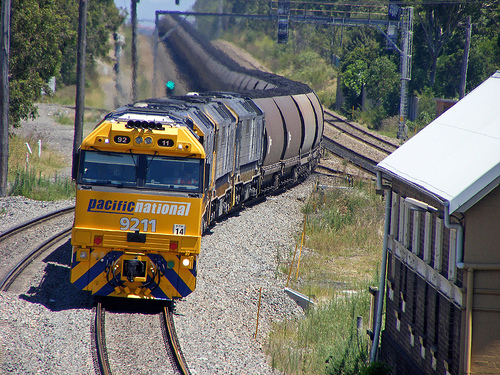 Hunter Valley Coal Train
[Source: Photo by Vince Wang
^http://www.railpage.com.au/f-t11342636-s30.htm] Hunter Valley Coal Train
[Source: Photo by Vince Wang
^http://www.railpage.com.au/f-t11342636-s30.htm]
.
The Chairman of a Hunter Valley health lobby group has described as ‘unconscionable’ the lack of research by both State and Federal Governments into the health impacts of mining.
Dr John Drinan from the Singleton Shire Healthy Environment Group says the latest report just reinforces what Hunter mining communities have been calling for.
“It really is unconscionable that governments have allowed this sort of thing go on for years knowing full well there are implications of coal mining on health,” he said.
“Here we are in the Hunter Valley generating billions of dollars a year for the Government coffers, yet they’ve seen no need to put any effort back into finding out whether this has any deleterious impacts on our health.”
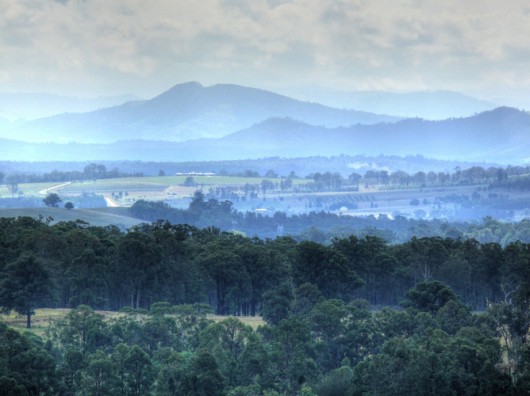 Coal mining in NSW’s Hunter region co-exists with wine growing, racehorse breeding, dairy and other pastoral industries.
[Photo by Jo Schmaltz]. Coal mining in NSW’s Hunter region co-exists with wine growing, racehorse breeding, dairy and other pastoral industries.
[Photo by Jo Schmaltz].
.
‘Research needed into Hunter’s coalmines’
[Source: ‘Research needed into Hunter’s coalmines’, by Ian Olver, The Herald (newspaper), 20121102, ^http://www.theherald.com.au/story/524537/opinion-research-needed-into-hunters-coalmines/]
.
Cancer Council Australia chief executive, Professor Ian Olver:
<<I did not expect the lecture room at the University of Sydney to be overflowing for the release of a report on the impact of coalmining. But it was.
The group Beyond Zero Emissions had commissioned Ruth Colaguiri’s group at the university to review all the research in Australia and overseas on the effect of coalmining on local communities. They were particularly worried about the Hunter Valley – and with reason.
.
The population of 700,000 lives in a region that has more than 30 open-cut coalmines and six coal-fired power stations.
.
As I left the launch of the report I fell into step with a person from the area. He told me his village was next to go. An open-cut mine was coming.
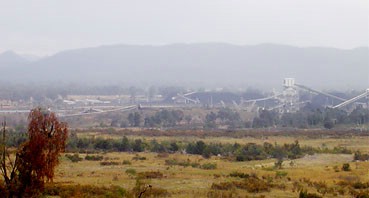 Dust clouds the view of the Ulan Mine conveyor belts
(North west of Mudgee, NSW) Dust clouds the view of the Ulan Mine conveyor belts
(North west of Mudgee, NSW)
.
I asked about compensation, but, more resigned than angry, he told me that he was to receive none. He couldn’t sell, because who would buy with the mine approaching?
A mine worker for years, he would have to stick it out on his few acres growing grapes with an open-cut mine for a neighbour, located within a few kilometres.
The University of Sydney researchers reviewed 38 studies:
.
‘Data from Appalachian coalmining counties in the United States or areas in Nova Scotia, Canada, most nearly paralleled local conditions. Adults living in coalmining communities had higher rates of lung, heart and kidney disease and lung cancer. Hospitalisations for chronic lung disease increased with the amount of coal mined…’
.
Children had more asthma and higher levels of lead and cadmium in their blood. There was a higher incidence of some birth defects.
It was a similar story for those living near coal-fired power stations, with adults having a higher death rate from cancers of the lung, head, throat, bladder and a higher incidence of skin cancer and children have more breathing difficulties. They also reported more miscarriages. People living in these areas score lower on assessments of their quality of life.
Why would these illnesses occur?
Each stage of coal production – mining, transport, washing, burning the coal and disposing of the waste products – releases particles into the environment that have the potential to cause harm if the level of exposure is high and prolonged. Burning coal makes a contribution to greenhouse gases. Waste products including heavy metals have the potential to contaminate the water supply.
So what about in the Hunter Valley? Are the same health problems reported there?
We don’t know. The detailed research needed has not been done. The main thrust of the report is that we need to collect evidence so the extent of the health impact is known. Anecdotes are not sufficient. But the overseas studies give us a strong reason to push for local studies.
What we do know is that 16% of the Upper Hunter Valley consists of open cut coalmines and massive expansion is planned. It is only recently that the NSW Government has set up a network of stations to monitor particle pollution of the air. To be most valuable they will need to report each occasion when particle levels exceed acceptable limits and how frequently, rather than averages.
The report went further than documenting the health and environmental impacts of living near coalmines and coal-fired power stations. It also documented the adverse social impact on the surrounding communities.
This time there were studies from the Hunter Valley.
.
‘There is an injustice if people do not know the potential extent of the environmental damage, poor air and water quality and how it may damage their health.’
.
However, we need to know details about the levels of exposure to pollutants from mining in the Hunter and whether they are causing an increase in illness before we can ask the governments or the industry to increase protection. Communities become distressed by being disempowered and not being able to influence the changes that are reducing their living standards, and influencing their access to natural resources.
There is no doubt about the need for power production, but this needs to be balanced against harms to local communities. Diseases such as lung cancer are difficult to treat and we must seize upon any opportunity for prevention. Individual stories may raise awareness, but advocacy for change must be based on solid evidence and we must do the Australian research into the health impacts of coalmining on local communities to help us achieve a just balance.>>
.
Black Lung – centuries change but Coal Dust doesn’t
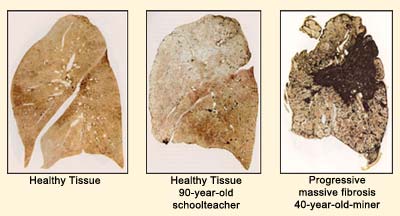 <<‘Black Lung’ is a legal term describing a preventable, occupational lung disease that is contracted by prolonged breathing of Coal Mine Dust. Described by a variety of names, including: <<‘Black Lung’ is a legal term describing a preventable, occupational lung disease that is contracted by prolonged breathing of Coal Mine Dust. Described by a variety of names, including:
- Miner’s Asthma
- Silicosis
- Coal Workers Pneumoconiosis
- Black Lung
.
.. all are all dust diseases with the same symptoms.
.
Like all occupational diseases, black lung is man-made and can be prevented. In fact, the U.S. Congress ordered Black Lung to be eradicated from the coal industry in 1969. Today, it is estimated that 1500 former coal miners each year die an agonizing death in often isolated rural communities, away from the spotlight of publicity.>>
[Source: United Mine Workers of America,^http://www.umwa.org/?q=content/black-lung]
.
 Protesters on horseback take to the streets in November 2009 to voice concerns over the proposed Bickham coal mine (Hunter Valley)
Friends of the Earth Sydney congratulates Pages River and Tributaries Water Users Association and Rivers SoS Alliance in their successful campaign to stop the proposed Bickham open-cut coal mine and save the Pages River (near Scone in the NSW Hunter Valley). Protesters on horseback take to the streets in November 2009 to voice concerns over the proposed Bickham coal mine (Hunter Valley)
Friends of the Earth Sydney congratulates Pages River and Tributaries Water Users Association and Rivers SoS Alliance in their successful campaign to stop the proposed Bickham open-cut coal mine and save the Pages River (near Scone in the NSW Hunter Valley).
[Source: Friends of the Earth Sydney,
^http://www.sydney.foe.org.au/news/nsw-government-rejects-coal-mine-first-time-ever]
.
‘Coal industry thriving, but at what social and health cost?’
[Source: ‘Coal industry thriving, but at what social and health cost?’, by Ruth Colagiuri, Emily Morrice, The Conversation, 20121102, ^http://theconversation.edu.au/coal-industry-thriving-but-at-what-social-and-health-cost-9266]
.
<<If you believe industry propaganda, coal mining is a panacea not only for economic ills but also for smoothing troubled social waters. But a lack of local evidence about the health impact of the coal industry should give us all cause for thought.
With the highest density of coal mining activity close to towns and farms in Australia (well over 30 operating mines and six active coal-fired power stations, and the largest black coal exporting port in the world), many Hunter Valley residents remain unconvinced. Less than a two-hour drive north of Sydney, in one of the largest, most fertile, beautiful river valley systems in Australia, the Hunter region’s long tradition of coal mining has co-existed for many decades in balance with wine growing, racehorse breeding, dairy and other pastoral industries.
But the seemingly indiscriminate granting of mining licences by the previous state government (and little abatement likely under the current government) has put a major strain on relations between the mining industry, other local industries and the citizenry.
This is unsurprising considering inequities such as water rights favouring the coal industry over local farmers, the removal of local government input from the coal mine licensing process, and concerns about the transgenerational effects of irreparable environmental damage.
And then there’s health. Ongoing concerns and myriad anecdotal reports of serious health impacts have been expressed by both local communities and health professionals, and echoed by organisations such as Doctors for the Environment. But there’s virtually no hard evidence in the peer-reviewed literature to confirm or deny the negative health impacts on communities near coal mines or coal-fired power stations in Australia.
Such evidence is available in other countries and is summarised in a new independent report that cites 50 articles exploring the health and social harms of coal on community health from 13 countries. And it’s not pretty.
.
Health and Social Harms of Coal Mining in Local Communities:
.
Spotlight on the Hunter Region cites excess deaths from lung cancer, chronic heart, respiratory and kidney disease related to living near coal mines. The evidence is mostly from the United States and often features a dose-response effect related to coal quantity or surface area of the mine. Other effects include high blood levels of heavy metals in children, and higher rates of birth defects.
Living near coal combusting power plants is associated with excess death – in this case from lung, laryngeal and bladder cancer. Respiratory complaints, increases in non-melanoma skin cancers, still births and miscarriages are also reported.
So how alarmed should Australians be? The problem is we don’t really know. Mining methods, practices and regulatory controls vary across countries and may account for some of the reported health effects. As may factors such as difficulties in accurately measuring exposures to toxins and particulate matter in air pollution.
Despite these limitations, it would be irresponsible to ignore the possibility that some of the effects demonstrated in similar countries are likely to apply here.
The lack of local evidence in itself is alarming – particularly at a time when NSW Health is believed to be investigating a cancer cluster in the Illawarra mining region of the state. Six children living in close proximity are said to have developed either leukaemia or a lymphoma in the past five years.
A report by the Australia Institute and many other technical reports on the coal industry point out that externalities are rarely included in cost estimates of the benefits and harms of coal extraction and combustion. These factors include environmental damage, social costs such as tax subsidies to the industry (of up to $10 billion annually) and health harms estimated by the Australian Academy of Technological Sciences and Engineering(ATSE) at $2.6bn annually.
Nonetheless, major developments in the coal mining industry are underway. Massive expansion of the port of Newcastle – already the world’s biggest black coal exporting port – is in planning stages. Commonly referred to as the “T4” Project, Port Waratah Coal Services propose expanding their Kooragang terminal in Newcastle in order to increase coal exports by up to 120 million tonnes a year.
 CNA Coal, Muswellbrook
Hunter Valley CNA Coal, Muswellbrook
Hunter Valley
.
Further coal port expansions are also planned by North Queensland’s Bulk Ports Corporation’s at Dudgeon Point, south of Mackay, and Rey Resources are planning their “Duchess Paradise” coal mine, which lies on a coal reserve estimated at 500 million tonnes near the Fitzroy River in the Kimberley, Western Australia.
But we have a glaring absence of local evidence to determine what impacts these projects will have on the health of surrounding communities. Surely such evidence should play a role in policy and planning of the expansion of Australia’s coal industry. It would also help us, as a society, to make up our minds about what we value more – money or our people and the planet that sustains us.>>
.
 . .
‘Coal is killing Australia’, new book reveals’
[Source: ‘Coal is killing Australia’, new book reveals’, By Christa Schwoebel, 20120527, ^http://www.greenleft.org.au/node/51154]
.
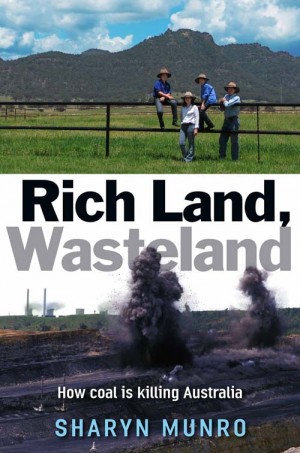
‘Rich Land, Wasteland’
book by Sharyn Munro
Exisle Publishing & Pan Macmillan
453 pages, pb, $29.99
^http://www.exislepublishing.com.au/Rich-Land-Wasteland.html
.
<<When a coalmine starts up near a township, a village or a farm it is to be expected that lives will change.
Indeed change is often promised and welcomed ― more Jobs, more money flowing into the community, better roads and services. In short, progress is promised.
The reality, however, is that not only do the benefits not evolve as the mines begin their operations, they destroy the land, pollute the water and air, erode people’s physical and emotional health and rip up the social fabric.
The media lead us to believe that Australia’s wellbeing depends on the mining sector. The more minerals that are exported, the healthier the Australian economy is and the better off we are. But such stories hide the real impacts of mining from most Australians.
Sharyn Munro puts aside “the diversionary cloud of spin” and tells the real story of coal mining. A resident of the upper Hunter who saw the coal mines taking over vast tracts of that valley, she spent a year travelling to the different parts of Australia where coalmining is destroying communities, livelihoods and ecosystems.
She found that “coal is killing Australia”.
Meeting victims of the industry in NSW, Queensland, Victoria, in WA and Tasmania, she records their stories. In Rich Land, Wasteland, she lets them tell their side of the story.
They tell us that there is “a war taking place in Australia”. It is an invasion where “the invaders are mostly foreign or multinational”. It looks like the second invasion of the continent.
The victims of this war, the people harassed and displaced by the mines, are fighting the invasion and mostly they have been fighting alone. They live in smaller communities or on the land, isolated from neighbours by distance and by the mines’ strategies of divide and take over.
All are deeply shocked by the lack of support from the governments and the legal system.
With their health, properties and livelihoods on the line, they try to stand up against the wealthy opponents.
The “warring sides are more unevenly matched than any David and Goliath cliche can convey”, the book says. Most of them have taken the fight up reluctantly. But if they are not despairing early on, they get increasingly incensed by the injustice they experience.
All are disillusioned, if not deeply depressed, by the failure of democratic processes.
Occasionally, they win a small concession ― only to be wiped out again by the mining companies’ blatant disregard of the conditions placed on their operations or by changed government regulations.
Where the invasion has been beaten off, as in the Margret River region in WA, the attackers regroup a short distance away, where they hope resistance will be weaker.
Each of the individual stories Munro presents is underpinned with meticulously researched facts and figures. Judiciously inserted at relevant points, these expand the anecdotal evidence into a systematic documentation of the true impact of coalmining.
In some sections, the seemingly obvious becomes a revelation.
.
Take the impact of dust:
.
From the blasting and machinery working in open cut mines, to vast piles of overburdened, uncovered coal trains up to two kilometres-long on their way to the ports and fly-ash from the coal power stations, it negatively affects the health of people, animals and plants.
The dust consists of smaller and larger particles of lead, arsenic and mercury, which are inhaled and ingested by animals and humans. Its role in higher rates of health problems such as asthma have been proven, yet the government does not act.
Contrary to the findings and advice of medical experts, governments assures residents they have nothing to fear. In 2010, the Independent Review of Cumulative Impacts on Camberwell (Hunter) “dismissed fears mines are making people sick”.
The report advised people to stay inside, close doors and wear masks, put on air-conditioners and seek medical advice.
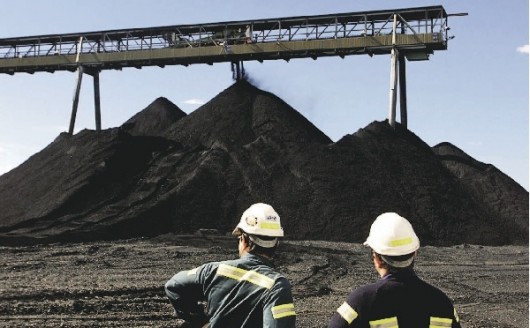 . .
Conditions placed on mining operations, such as to reduce dust, are hardly ever monitored ― except by the mining companies themselves. Their results never surprise.
There are many more, widely varied aspects to this war. These include issues such as ownership of mines and who benefits, the fast and huge expansions of coal mining as well as coal seam gas exploration and extraction, collusion of mine operators and government agencies, strategies applied to move people out of the way of mines, the impact of the predominantly male fly-in-fly-out workforce, higher road traffic, new exclusive rail lines and shipping in the Great Barrier Reef.
Everywhere there is environmental destruction, a lack of ― indeed the impossibility of ― site rehabilitation, and water depletion and water contamination. Everywhere, it poses the question: how can this happen in a democratic country such as Australia?
With so many details, an index would help reading and following up on some facts. The subheadings to the chapters that list locations help only to a point. I would have liked a list of acronyms and some maps.
However, when turning to the internet to look for the locations, I found that satellite maps gave extra insights into the vast onslaught of coal mines on the country.
Reading this book, veil after veil is lifted, revealing the reality of Australia today. It could be a deeply depressing book, if it weren’t for the encounters with many individuals who are standing up and speaking out.
As one says, “you must fight or nothing happens”. Munro encourages the readers to add their voices, stop the plunder and “speak up for the smart, sustainable and humane Australia we could be instead” ― the country worth fighting for.>>
.
 Government vested interest in Coal Mining
‘In 2008-09 the royalty revenue generated by the NSW minerals sector was $1.28 billion, with coal accounting for approximately 95% of the total.’
[Source: New South Wales Government, Division of Resources and Energy – Minerals and Petroleum,
^http://www.resources.nsw.gov.au/resources/royalty, website accessed 20121111] Government vested interest in Coal Mining
‘In 2008-09 the royalty revenue generated by the NSW minerals sector was $1.28 billion, with coal accounting for approximately 95% of the total.’
[Source: New South Wales Government, Division of Resources and Energy – Minerals and Petroleum,
^http://www.resources.nsw.gov.au/resources/royalty, website accessed 20121111]
.
‘Hunter coal mine fined for dust emissions‘
[Source: ‘Hunter coal mine fined for dust emissions’, by Cole Latimer, Safe To Work, 20120524, ^http://www.safetowork.com.au/news/hunter-coal-mine-fined-for-excessive-dust]
.
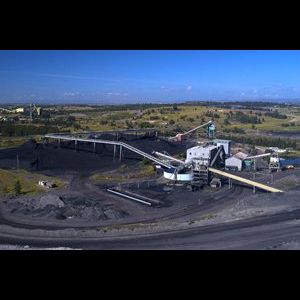
<<Rio Tinto’s Mt Thorley Warkworth coal mine has been fined by the NSW Department of Planning and Infrastructure after failing to minimise dust emissions.
A (paltry) $3000 fine was issued after an investigation into “significant dust emissions from the Mt Thorley Warkworth mine on Sunday 13 May,” the Department says.
The miner has been warned that “further breaches for dust emissions are likely to attract stronger enforcement action by the Department, including the potential for criminal proceedings in the Land and Environment Court”.
In January the mine came under fire for the placement of its water fill points, which reduced the effectiveness of the water cart fleet and its dust reduction activities.
Rio stated that this issue had been identified in 2010, and it had since secured funding to solve the problem, with the initial two fill points commissioned in December 2011, and the remaining three in February.
These new fill points are predicted to cut fill times by up to 15 minutes, while the storage capacity of each point has also been increased to enable continuous refills.
Rio stated that an early warning system for faults had been installed as well as automatic cut off.
It also received a number of noise complaints in January, accounting for 85% of submitted complaints.
According to the Department, breezes and low cloud cover contributed to noise transfer from the mines.
The Department’s executive director for major development assessment, Chris Wilson, said the mine has now failed to minimise offsite dust emissions and had not suspended or modified operations.
“Both the Upper Hunter Air Quality Network and the mine’s own real-time air quality monitor showed a spike in dust levels above the permitted 24 hour average,” Wilson said. “Our investigations have indicated that the mine’s air quality and dust mitigation measures required under the mine’s planning approval, were not adequate on that day.”
While the complaints occurred over a weekend, an officer from the nearby Singleton compliance unit was able to immediately attend the mine; Wilson adding that “the compliance officer observed that the mine was continuing to operate a dragline and excavator, despite dust being generated.
“These activities should have been suspended by the mine in the windy conditions.”
Under its existing operating approvals, the mine has to ‘implement best management practice to minimise odour, fume, and dust emissions’.
“This includes commitments by the mine to minimise wind-blown and traffic generated dust from coal handling and coal stockpiles, using water sprays on coal stockpiles to reduce airborne dust and using water trucks to minimise dust on roads. “The inspection found these commitments were not being complied with on 13 May,” Wilson said.
“Consequently large volumes of dust from mining operations flowed across the Putty road and the dust was also visible from the Golden Highway,” he added. “The decision to issue a penalty notice to the mine follows two previous warning letters last year in relation to dust.”>>
.
 . .
‘Foreign investors sow deep roots in food bowl’
[Source: ‘Foreign investors sow deep roots in food bowl’, by Leonie Lamont, Sydney Morning Herald (newspaper), 20110730, ^http://www.smh.com.au/nsw/foreign-investors-sow-deep-roots-in-food-bowl-20110729-1i4ar.html]
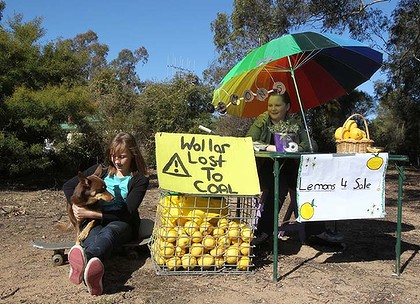 Sour taste … Ruby Marshall (age 12), and her sister April (age 11)
Display an anti-mining sign at their lemon stall in the former farming village of Wollar
(Photo by Peter Rae) Sour taste … Ruby Marshall (age 12), and her sister April (age 11)
Display an anti-mining sign at their lemon stall in the former farming village of Wollar
(Photo by Peter Rae)
.
<<Mining and energy companies have bought more than 35,000 hectares of rural land in NSW in the past year, in a scramble with foreign investors in agriculture to snap up prime sites.
A Herald review of land sales found the mining interest was focused on a swath of rural land extending from the Upper Hunter through the rich Liverpool Plains to Narrabri. Mining companies spent more than $85 million buying 27,500 hectares in this area – nearly 80 per cent of the total bought.
Community agitation about the collision of farming and mining interests has risen with miners’ purchases including $14 million paid by Coalworks for Kurrumbede, the family property of poet Dorothea Mackellar, near Gunnedah.
The miners’ outlay of $113 million is challenging overseas investment in agriculture, which amounted to $125 million in the past year, buying 225,000 hectares. Despite the soaring dollar, Australia’s openness to foreign investment has made it an attractive destination for miners as well as investors and sovereign wealth funds seeking to exploit the growing demand for agricultural produce.
Chris Meares, a land agent and rural property expert, said over the past year the main ”buying power” had been institutions, corporates and mining companies – many foreign-owned.
”In the last two years, credit has got very difficult to obtain in Australia,” he said. ”Initially [after the global financial crisis] the overseas investors said the dollar was too high, but then they saw some very good investment opportunities sitting there. Commodity prices were strong and there was little opposition from Australian investors, so they could come in and buy assets globally at very cheap rates. That’s what’s happened.”
The mining boom in NSW is underpinned by prices for thermal and coking coal, which have jumped almost 60 per cent over the past five years. Export prices for liquefied natural gas – which are driving the coal seam gas boom in Queensland and NSW – have risen 36 per cent in five years and are still rising.
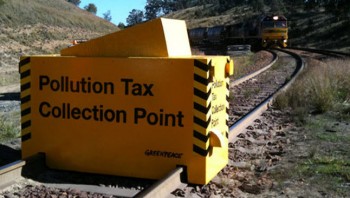
Mining companies said it was wrong to assume the sales meant the land was excised from agricultural use. Aston Resources said its 2800 hectares near Tamworth, which it bought for $4 million, would not be mined as it was an environmental offset – high value native trees and grassland next to the Mount Kaputar National Park, and cleared grazing land that would be leased to the original farming owner.
But Bruce Marshall, who moved to the former farming village of Wollar 20 years ago, said expansion by the mining giant Peabody Energy there had ”split the community”. Anti-mining signs adorn his fence and the fresh lemon stall run by his daughters April, 11, and Ruby, 12, beside the road to the mine site2.
This month, the NSW government set new environmental and consultative conditions for miners and extractors.
The NSW Minister for Resources and Energy, Chris Hartcher, said there had been a ”changed paradigm” that people had to acknowledge but residents and mining companies needed to know what the rules were.
”If it is essential to protect water or Prime Agricultural Land. We will not shy away from making the decision it is inappropriate [to mine] in these areas.”
The Herald used RP Data, a property information system, to review sales of more than 250 hectares during the past year. The review did not cover purchases by individuals – typically farming families – and small companies associated with them.
The biggest mining spender was Shenhua Watermark, majority owned by the Chinese government, which spent $26.5 million on 2700 hectares in the Gunnedah area. It has spent more than $200 million acquiring land for its planned $1.7 billion open-cut coal mining operation.>>
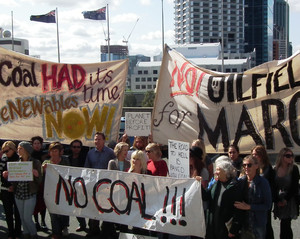 . .
‘Cancer concern for people surrounded by coal mines’
[Source: ‘Cancer concern for people surrounded by coal mines’, by Richard Noone, The Daily Telegraph, 20121030, ^http://www.news.com.au/national/cancer-concern-for-people-surrounded-by-coal-mines/story-fndo4bst-1226505615788]
.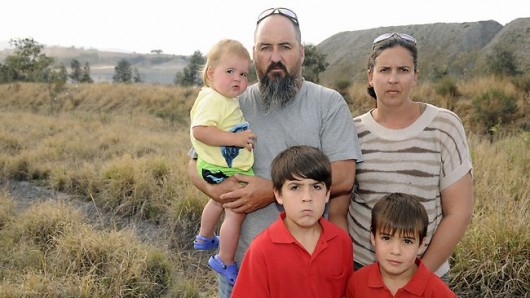 Jason and Belinda Passlow with children Harrison, Lachlan and William in Bulga (Hunter Valley)
(Photo by Waide Maguire, The Daily Telegraph) Jason and Belinda Passlow with children Harrison, Lachlan and William in Bulga (Hunter Valley)
(Photo by Waide Maguire, The Daily Telegraph)
.
<<People surrounded by coal mines in the Hunter Valley could be at more risk of cancer, heart, lung and kidney disease and birth defects.
A new report has found serious illnesses were rife in communities near mines overseas. The report calls for an urgent health impact study in the Hunter after analysis of 50 peer-reviewed research papers from 10 countries, including the US, the UK and China, found a wide range of adverse health effects in those living close to mines.
Lead author, Sydney University associate professor Ruth Colagiuri, said similar studies in Australia’s largest coal mining region were needed “so governments and community can make informed decisions and develop policies to minimise health harms”.
The study – Health and Social Harms of Mining in Local Communities: Spotlight on the Hunter Region – was commissioned by Beyond Zero Emissions. “With plans for 30 new or bigger coal mines, an independent authority is urgently needed to monitor emissions in the region and for an in-depth health study to take place,” BZE spokesman Mark Ogge said.
Mother-of-four Belinda Passlow said her two eldest children, Eleanor, 14, and Lachlan, 10, developed asthma after moving to Bulga, a village near four open cut mines in the Upper Hunter. She said they were forced “like most people around here” to put up with constant dust.>>
.
‘Stand with Coalfield Residents at Appalachia Rising (USA)’
[Source: ‘Stand with Coalfield Residents at Appalachia Rising’, by ‘Carolyna’, Greenpeace (USA), 20100917, ^http://members.greenpeace.org/blog/carolyna/]
.
Appalachia Rising is three days of coalfield residents and activists from across the country standing together for an end to Mountain Top Removal (MTR), an extremely destructive form of mining where the tops of mountains are blown off to extract the coal seams below.
I saw firsthand the effects of MTR on Appalachian communities while visiting Rock Creek, West Virginia (USA) this past January. Below is a selection of photos that my friend, Phoebe Neel, and I shot while bearing witness to the destruction.
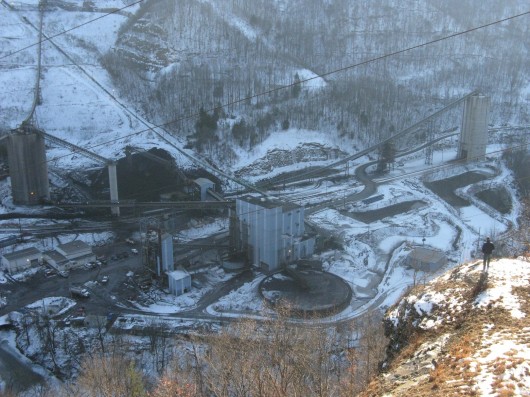 Goals Coal Plant in WV, owned by Massey Energy Goals Coal Plant in WV, owned by Massey Energy
.
This behemoth of a complex owned by Massey Energy contains the Goals Coal Processing Plant.
Above it, sits the Shumate Coal Sludge Impoundment Pond, which contains 2.8 billion gallons of toxic coal waste. Beyond that is the Edwight Mountain Top Removal site, whose blasting puts the dam at risk of failing.
Also out of the picture is Marsh Fork Elementary, which would be wiped out if such a failure were to occur. Thankfully, the community won a six year fight this past April to build a new school, which will break ground next year.
Just realized that most of my description was for what is NOT shown in this photo. It says something when you need to be that high up to see the extent of the problem.
.
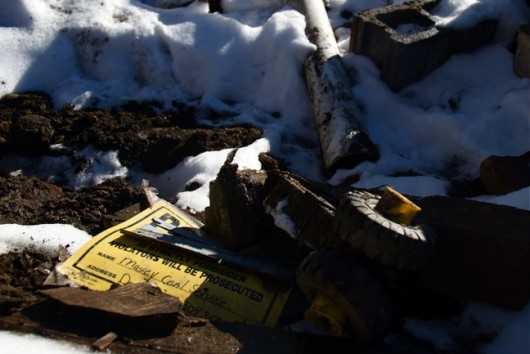 Massey Energy Notice
(Photo by Phoebe Neel) Massey Energy Notice
(Photo by Phoebe Neel)
.
A ‘No Trespassing’ notice from Massey Energy in the rubble of a demolished house. Massey bought out the residents of Lindytown, West Virginia (USA) one by one so the company could level the town and expand the mountaintop removal site that borders it. Saying the residents had a choice in the matter is a farce – with the noise, dust, and polluted well water that comes with MTR, you trade your health for your home.
.
 Demolished home in Twilight, West Virginia Demolished home in Twilight, West Virginia
.
This is a wider shot of Lindytown, which shows three homes that have been bulldozed. Surveying the scene, I remember thinking that it could’ve been the site of a natural disaster – a storm that had decimated the neighborhood. However, this was caused by man and was just a precursor to the much wider destruction of themining to come. Nothing would be rebuilt; those concrete steps would always lead to nowhere.
The next two photos should be looked at as a pair.
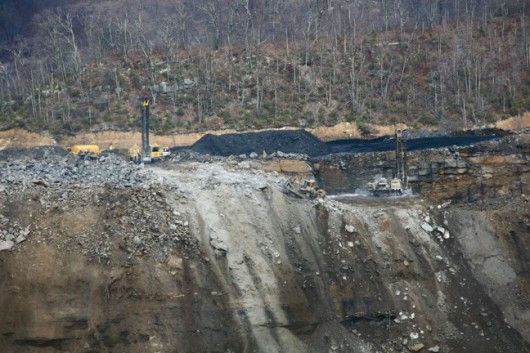 Bee Tree site
(Photo by Phoebe Neel) Bee Tree site
(Photo by Phoebe Neel)
.
This one is of the Bee Tree site in Pettus, West Virginia (USA) and the huge earth-moving machines that are used to extract the exposed coal. The striking thing about this for me is that all the rubble is refered to as “fill,” which companies like Massey dump into neighboring valleys, burying streams and polluting drinking water.
.
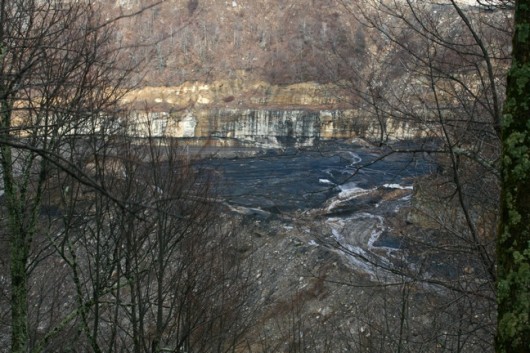 Brushy Fork Impoundment
(Photo by Phoebe Neel) Brushy Fork Impoundment
(Photo by Phoebe Neel)
.
This last photo is of the Brushy Fork Impoundment, which at 8.2 billion gallons, holds much more coal waste than the Shumate Impoundment. However, it has one important thing in common – it’s also located close to an MTR site, where blasting can affect its structural integrity. It lies less than half a mile away from the Bee Tree site. Marfork Coal, a subsidary of Massey Energy, estimates a dam failure could cause a wave of coal sludge as high at 72 ft.
This is just a small selection of what I witnessed in West Virginia. And when you come to DC for Appalachia Rising, you won’t see any of these scarred landscapes. But what you will see are more people like Maria Gunnoe – people who refuse to give up and instead are rising up.
.
Coal Bin Flag
.  Coal Dust Victim Coal Dust Victim
.
<<The dirtiest part of resurrecting this old house was cleaning the Coal Bin.
If you’ve never been in a Coal Bin, you may not have a sense of how coal dust can get everywhere. I mean ev-er-y-where. Coal dust is insidious. It gets everywhere on your body – even in places you didn’t know you had places. And it instantly goes airborne when disturbed from its decades-long slumber.
A normal shop vacuum filter has no use in this environment. Coals dust passes right through the filter. The only way to capture the dust is with one of the expensive filters.
Our coal bin took two days to clean and dismantle.
The best part about the job was finishing. The second best part was this old flag.
This 48 star flag is easy to date. Arizona, our 48th state was added in 1912, roughly four years after Harry & Carrie Benham built this great old house. It was replaced by our current 50 star flag in 1960 when Alaska and Hawaii were added to the Union. So in 2007 when I found this flag in the coal bin it was between 47 and 95 years old.
I can’t narrow it down any more than that, but I like to imagine the flag was placed there about the time the old coal burner furnace was converted to gas – maybe in the 1950s.>>
[Source: ^http://residencehill.blogspot.com.au/2012/03/coal-bin-flag.html]
.
 ‘Devil’s Dust’ – past decades of asbestos fibre exposure are being repeated with coal dust exposure
..it’s just that the law hasn’t caught up yet. ‘Devil’s Dust’ – past decades of asbestos fibre exposure are being repeated with coal dust exposure
..it’s just that the law hasn’t caught up yet.
.
Tags: Appalachia Rising, Appalachian Mountains, Black Lung, Cancer Council Australia, Chris Hartcher, Coal Dust, Coal Mining, Coal Workers Pneumoconiosis, Coalfield Residents, coalmines, devil's dust, Edwight Mountain Top Removal, food bowl, Goals Coal Processing Plant, Greenpeace, Hunter Valley, lung disease, Massey Energy, Miner's Asthma, mining royalties, Ohio Valley Environmental Coalition, Prime Agricultural Land, Shenhua Watermark, Shumate Coal Sludge Impoundment Pond, Silicosis, Singleton Shire Healthy Environment Group, Wollar
Posted in Threats from Mining | No Comments »
Add this post to Del.icio.us - Digg
Wednesday, July 18th, 2012
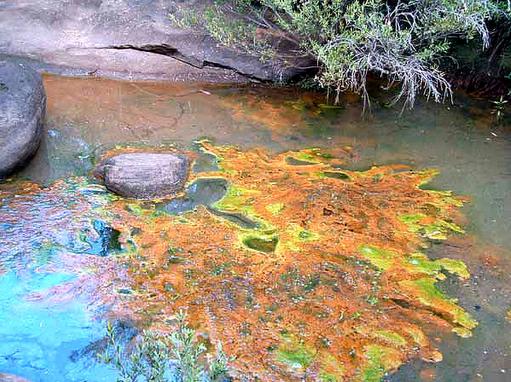 Toxic Omelette killing all life in the Georges River Toxic Omelette killing all life in the Georges River
The EPA in New South Wales (NSW) is accused of ignoring BHP’s coalmine’s toxic contamination of Georges River for over a decade
[Source: ‘Coalmine discharge fouls Australia’s Georges River’, by ‘Jim’, 20100803, Desdemona Despair .net, ^http://www.desdemonadespair.net/2010/08/coalmine-discharge-fouls-australias.html]
.
Ed: The Political Climate Change Fad has negated funding of the Environment Protection Authority from critical Pollution Control.
.
 The Upper Georges River
Near the Dharawal National Park, NSW
[Source: ‘Coalmine discharge fouls Georges River’, ^http://off.oatleypark.com/?p=904] The Upper Georges River
Near the Dharawal National Park, NSW
[Source: ‘Coalmine discharge fouls Georges River’, ^http://off.oatleypark.com/?p=904]
What is the Environmental Protection Authority (EPA) in New South Wales (NSW) doing?
It took an arbitrary bushwalk by a few bushwalkers of the local Macarthur Bushwalkers Club to by chance discover pollution of a remote section of the Georges River down from a coal mine in the Illawarra Region of NSW.
Although they dutifully reported the pollution incident to the NSW EPA, nothing was done, and that was over ten years ago, yet the mine has continued polluting the Georges River.
Labor and Liberal successive NSW Governments have known for more than a decade about this major toxic plume in the Georges River from a coalmine owned by BHP Billiton discharing into the upstream tributary Brennans Creek, but have never pressed the company to stop polluting. Why?
Metals such as zinc, copper, nickel and aluminium, as well as elevated levels of arsenic, are much higher than healthy guidelines, and the contamination has seriously damaged the ecosystem of the river for 15 kilometres downstream from the mine, documents obtained by the Herald show. Environment groups have begun a civil court case against BHP Billiton, which operates the West Cliff coalmine near Campbelltown via a subsidiary company.
.
Ed: This is Australia in 2012, not 1912!
.
The O’Farrell Government‘s Environment Minister, Robyn Parker, said yesterday:
”The EPA needs to lift their game,” Parker said. ”We’ve put them there, and given them increased powers and increased responsibility, and I need to see some action from them.”
Yet on the same day, Parker has hypocritically announced savage staff cuts to the Environment Department. Internal documents circulated among employees said the Department had committed to cutting costs in kangaroo harvesting programs [Ed: poaching wildlife?] , reducing wilderness and wild river assessments, deregulating wildlife licensing where appropriate, scaling back soil and salinity research and ”reducing effort in our biodiversity programs” i.e. ‘frontline services’.
.
Ed: The O’Farrell Government’s Environment Minister, Robyn Parker, has just announced axeing 350 jobs in Environment and Heritage including in the EPA as well as culling many programmes in national parks and animal management, all to save $101 million by 2016. Notably in the O’Farrell Budget 2012-13, the sum of $150,000,000 has been “appropriated to the Treasurer for the recurrent services of the Advance to the Treasurer.” [Clause 18, p16, Budget Paper Appropriation Bill 2012, >Read Bill]
.
Jul 2012: Miner BHP Billiton sued for river pollution by its West Cliff Colliery near Appin
[Source: ‘Regulator ignores toxic plume polluting river for a decade’, 20120718, by Ben Cubby, Environment Editor, Sydney Morning Herald, ^http://www.smh.com.au/environment/conservation/regulator-ignores-toxic-plume-polluting-river-for-a-decade-20120717-228jw.html]
.
Listed Australian Mining Conglomerate, BHP Billiton at its BHP Billiton’s Illawarra Coal subsidiary ‘Endeavour Coal‘, received a court summons yesterday, but did not respond directly to questions. Instead, it publicised a brief PR legal statement stating: ”The company complies with environmental regulations and is reviewing the details of this matter.”
A string of correspondence between the company and the EPA goes back as far as 2002, and shows that the regulator had been aware of discharges from the mine and some of its environmental impacts for most of that time.
The discharges from the mine flow into Brennans Creek, a tributary of the Georges River, and contain pollution from coal washing, water that has been pumped out of the mine tunnels, and stormwater runoff.
But the matter became public only because bushwalkers noticed the pollution and arranged for independent tests by Ian Wright, an environmental scientist at the University of Western Sydney.
About two years ago Dr Wright took a group of students and some rudimentary laboratory equipment to the river and has since returned many times to check and recheck the results.
”I thought ‘it can’t be as bad as it looks’. But I was wrong about that. You could just see the change in the water,” Dr Wright said. ”It was grey coloured. There was a lot of turbidity and coal ash.”
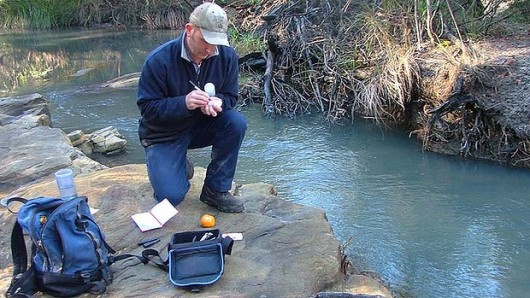 ”I thought ‘it can’t be as bad as it looks”
… UWS Environmental Scientist, Dr Ian Wright. ”I thought ‘it can’t be as bad as it looks”
… UWS Environmental Scientist, Dr Ian Wright.
.
The scientific results showed startling differences from some of the pristine waterways nearby, on the edge of the Dharawal National Park. The aquatic invertebrates – mainly small insects – that form the basis of the food chain were either very scarce or missing altogether.
”It’s knocking around the food chain and the biology in the Georges River,” Dr Wright said.
”Upstream, we’ve got the full complement of invertebrates that you would expect to find. Downstream, there are groups missing and others at very low abundance. The invertebrate data is consistent with a very polluted or degraded waterway.”
The court case is brought by the National Parks Association of NSW and the Macarthur Bushwalkers Club.
Ed: Natural Justice defended not by the EPA, but by the Macarthur Bushwalkers Club (commercial income zero) versus BHP Billiton (commercial income US$37.5 Billion)
. Bushwalkers
Bushwalkers
.
2010: ‘Coalmine discharge fouls Georges River‘
[Source: ‘Coalmine discharge fouls Georges River’, 20100804, by Ben Cubby, Environmental Reporter, Sydney Morning Herald, ^http://www.smh.com.au/environment/coalmine-discharge-fouls-georges-river-20100803-115gr.html; ‘Coalmine discharge fouls Australia’s Georges River’, by ‘Jim’, 20100803, ^http://www.desdemonadespair.net/2010/08/coalmine-discharge-fouls-australias.html]
.
‘Contaminated water from a coalmine [BHP Billiton’s Endeavour Coal] is flowing into the Georges River, south of Sydney, at levels that are toxic to aquatic life, an independent water quality report has shown.
A plume of saline water stretched along the river for 15 kilometres from the discharge point of an underground mine operated by Endeavour Coal, a subsidiary of BHP Billiton’s Illawarra Coal.
Discharges from Endeavour Coal’s West Cliff Colliery near Appin are ”causing serious water pollution that is very likely to be damaging in-stream ecosystems,” says the report, which was completed on a voluntary basis by researchers from the University of Western Sydney.
But the environmental protection licence for the mine’s wastewater discharge does not limit the amount of saline water that can be flushed into the river.
”I can’t believe that we have put out something called an environment protection licence without any provision to protect the environment,” one of the authors, Dr Ian Wright, a freshwater ecologist at UWS, said. ”Salt at these levels is huge in the context of a river … If you sprayed it on your tomatoes they would wilt.”
The NSW Department of Environment, Climate Change and Water said it was evaluating salt discharge levels that had already been measured by BHP Billiton at the site.
”There is currently no limit for salinity,” a spokesman for the department said. ”However, salinity discharges to Brennans Creek are currently regulated by a staged pollution reduction program under the current environment protection licence.”
When tested last month, the water discharged from the mine was five times more saline than the safe level recommended by the Australian and New Zealand Environment Conservation Council, a standard used by governments to determine water quality for aquatic life. It was nearly 10 times more saline than water in surrounding creeks.
The researchers tested upstream and downstream from the discharge pipe and also the water flowing directly from it.
They concluded that the environmental protection licence ”provides little effective protection to the Georges River” and said it was likely to damage the river’s ecosystems, meaning small invertebrates, fish and related denizens of the local food chain.
The colliery forms part of the company’s proposal to extend a series of coalmines around the township of Appin, so as to be able to extract $2 billion worth of coal a year for 30 years..
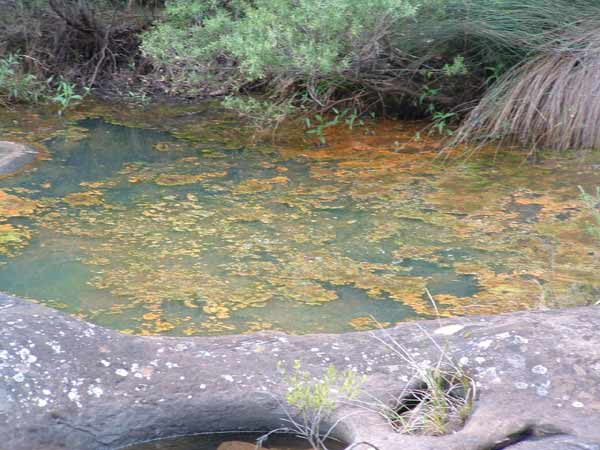 Contamination from coal mining near the Cataract River in Australia, November 2007
[Source: ^http://www.georges-river-macarthur.com/graphics/pollution/05_08.jpg] Contamination from coal mining near the Cataract River in Australia, November 2007
[Source: ^http://www.georges-river-macarthur.com/graphics/pollution/05_08.jpg]
.
Jan 2011: Meanwhile Barry O’Farrell pledges to Protect Wilderness
[Source: Barry O’Farrell pledges to Protect Wilderness, by Ben Cubby and Sean Nicholls’, 20110108, ^http://www.illawarramercury.com.au/news/local/news/general/barry-ofarrell-pledges-to-protect-wilderness/2041885.aspx?storypage=0]
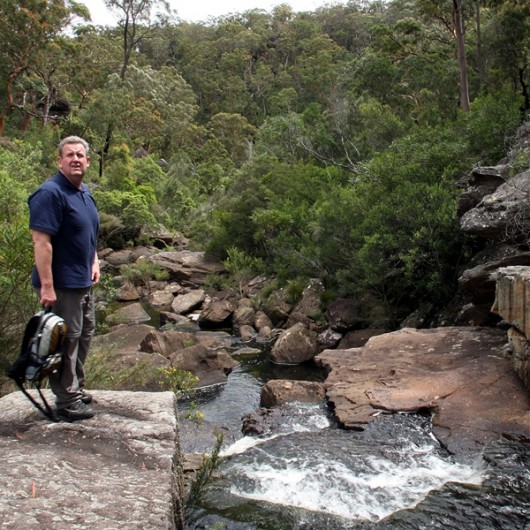 Premier Barry O’Farrell
Next to a watercourse in Dharawal National Park, that flows into the Georges River
Premier Barry O’Farrell
Next to a watercourse in Dharawal National Park, that flows into the Georges River
Jun 2012: O’Farrell now in government: “No deal has been done” with the mining company”
[Source: ‘Sydney snares park conservation event’, by Heath Aston, Merredin Mercury, 20120617, ^http://www.merredinmercury.com.au/news/national/national/general/sydney-snares-park-conservation-event/2592836.aspx]
.
‘Thousands of hectares of pristine wilderness near Appin, fought over by mining and environment interests for decades, will be saved and opened to the public as a national park if the NSW Coalition wins government in March.
But the announcement, to be made today by Opposition Leader Barry O’Farrell, sets up a potential conflict with BHP Billiton, which still holds the right to mine the billions of dollars worth of coal in the area.
The park, based on the Dharawal State Conservation Area, would add about 6200ha of bushland to the public estate, and provide one of the final pieces to the jigsaw of protected wilderness areas around Sydney.
It is one of the last remaining areas of intact natural bushland near the city, and sits between the Royal National Park and the Blue Mountains World Heritage Area.
Mr O’Farrell said “no deal has been done” with the mining company, which revised plans to mine under the conservation area in October but retains the right to apply again over the 30-year life of its lease.
Mr O’Farrell, who hiked in the area yesterday with environment groups, acknowledged the Coalition would need to enter into discussions about potential compensation.
“We will be having sensible discussion with the relevant stakeholder to get the best outcome for the community,” he said.
“It’s an area that has significant Aboriginal history, it has significant environmental history. It’s accessible, which means … people could go and visit and have access to our great natural environment.”
A peak environment body, the Nature Conservation Council of NSW, and the National Parks Association welcomed the plan.
“We see the Dharawal National Park proposal as an important step towards better conservation in Sydney’s drinking water catchment and beyond,” the council’s director Pepe Clarke said.
Head of the Total Environment Centre Jeff Angel said: “We look forward to more enlightened environment policies from the Coalition and note the new park should be gazetted without a depth restriction in order to protect it from mining.”
A BHP Billiton subsidiary, Illawarra Coal, had planned to dig up $60 billion worth of coal over the next 30 years, much of it from under Dharawal.
The area became the centre of a bitter campaign over reconciling coal mining and clean drinking water catchments. It contains 632 Aboriginal sites, as well as 226 upland swamps filtering water into the Georges River through 46 streams. More than 200 native animal and plant species are found there, including the vulnerable powerful owl, yellow-bellied glider and eastern pygmy possum.
The mining plan was revised in October, after the NSW Planning Assessment Commission released a scathing report into the proposed mine, which was expected to crack the surface of the conservation area and drain some of its water-filtering swamps.
In a landmark review, the commission cited the threat to water catchments and concluded that society would be better off if the coal was left in the ground.
A new plan excluding coal mining under Dharawal and other vulnerable areas is being considered by the Government.
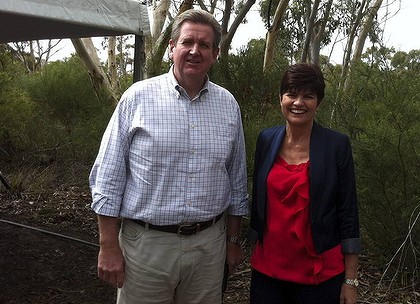 Premier Barry O’Farrell and his Environment Minister Robyn Parker opening Dharawal National Park. Premier Barry O’Farrell and his Environment Minister Robyn Parker opening Dharawal National Park.
.

Further Reading:
[1] Georges River Macarthur Region, ^ http://www.georges-river-macarthur.com/gr_cataract_river.html
.
[2] ‘Dharawal new national park is born’, by Murray Trembath, 20120327, ^ http://www.theleader.com.au/news/local/news/environment/dharawal-new-national-park-is-born/2501284.aspx
.
[3] Georges River, ^ http://www.georgesriver.org.au/
.
[4] ‘Parks will go unstaffed as environment jobs slashed’, 20120718, by Ben Cubby and Josephine Tovey, Sydney Morning Herald, ^ http://www.smh.com.au/environment/conservation/parks-will-go-unstaffed-as-environment-jobs-slashed-20120717-228cn.html]
.
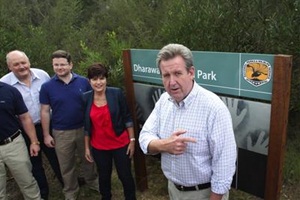
.
Tags: Aluminium, Arsenic contamination, BHP Billiton, Brennans Creek, Coal Mining, Copper, Endeavour Coal, Environmental Protection Authority, EPA, Georges River, Macarthur Bushwalkers Club, National Parks Association of NSW, Nickel, O'Farrell Government, River Pollution, Robyn Parker MP, Toxic Omelette, West Cliff Colliery, Zinc
Posted in Threats from Mining, Threats from Pollution | 1 Comment »
Add this post to Del.icio.us - Digg
Saturday, May 14th, 2011
In the north-western area of the Blue Mountains region of New South Wales (eastern Australia) lies the ancient Gardens of Stone. The area is so named because of its spectacular and rare sandstone rock formations known as ‘pagodas’ (large tapered, stepped or laminated sandstone formations) along with the abundance of native flora and fauna that thrive there.
Yet since November 2009, part of this beautiful pagoda country (some 1088 hectares of the Ben Bullen State Forest) with its important wildlife habitat, has come under threat of destruction from proposed open cut coal mining.
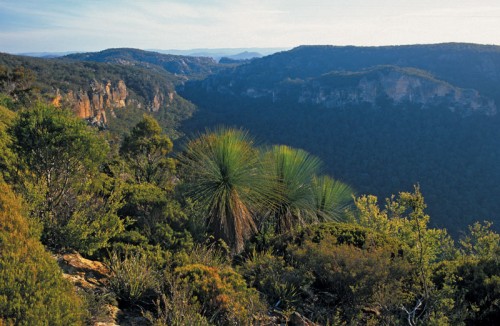 Johnson’s Grass Trees on Genowlan Mountain
© Photo by Jaime Plaza van Roon
(click photo to enlarge) Johnson’s Grass Trees on Genowlan Mountain
© Photo by Jaime Plaza van Roon
(click photo to enlarge)
.
Gardens of Stone National Park
.
In 1994, a Gardens of Stone National Park was created covering 15,000 hectares and joining Wollemi National Park on the northern part of Newnes Plateau. Other large landscape features include the outstanding mesas of Donkey Mountain in the Wolgan Valley and Pantoneys Crown in the Capertee Valley. Pantoneys Crown was previously protected in a much smaller nature reserve, and is the centrepiece of the commanding view of the valley from Pearsons Lookout on the Castlereagh Highway.
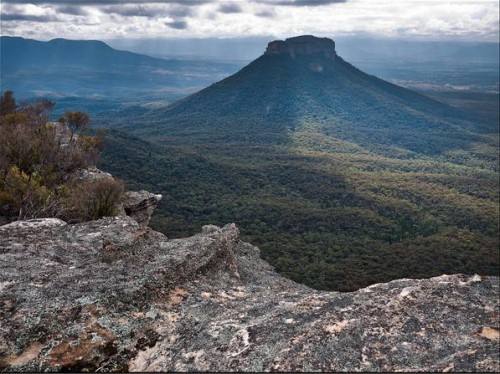 Pantoneys Crown, Gardens of Stone National Park, NSW
© Photo by David Braddon-Mitchell
[Source: ^http://dbm305.smugmug.com/Other/Pantoneys-Crown/13102823_B2fHx#950356269_VhEUF]
(click photo to enlarge) Pantoneys Crown, Gardens of Stone National Park, NSW
© Photo by David Braddon-Mitchell
[Source: ^http://dbm305.smugmug.com/Other/Pantoneys-Crown/13102823_B2fHx#950356269_VhEUF]
(click photo to enlarge)
.
Gardens of Stone Proposed Stage 2
‘But Gardens of Stone is an unfinished park. Environment groups, including Blue Mountains Conservation Society, have advanced a plan to protect much more of this unique landscape, by extending the park and creating a new state conservation area over adjacent plateaus and escarpments which are presently state forest and Crown land. The overall proposal is known as Gardens of Stone Stage 2, situated just north of the town of Lithgow. (The state conservation area classification allows underground coal-mining to continue.)
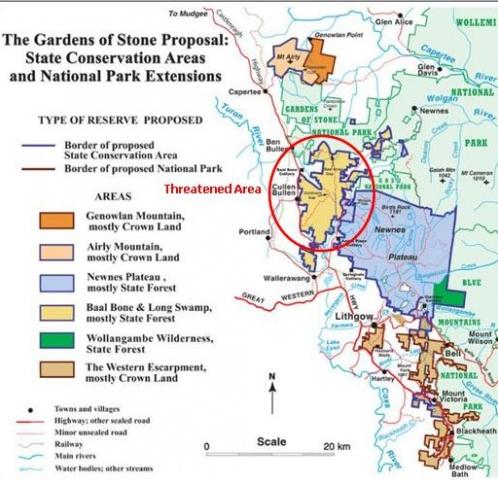 [Source: ^http://www.bluemountains.org.au/gos2.shtml] [Source: ^http://www.bluemountains.org.au/gos2.shtml]
‘These unprotected areas are just as valuable as the existing park, and are rich in special environments such as pagodas and canyons, nationally endangered high altitude shrub swamps and an unusual heathland on Genowlan Mountain. Rare and threatened species include the beautiful yellow Pagoda Daisy, Deane’s Boronia, Blue Mountains Water Skink, Wolgan Snow Gum, Giant Dragonfly, Regent Honeyeater, Genowlan Pea and Beautiful Firetail. In the western parts of the area the moist mountain vegetation begins to give way to drier inland communities, including grassy box woodlands, one of the most diminished and threatened environments in Australia.
‘The Gardens of Stone Stage 2 provides one of the most beautiful displays of sandstone geodiversity in Australia, comprising dramatically coloured sandstone escarpments and promontories, narrow canyons, cave overhangs, swamps and the complex arrays of rock pinnacles known as pagodas. The area has one of the Blue Mountains’ areas of highest plant diversity including ancient windswept montane heathlands, nationally endangered upland swamps, a unique species of snowgum (E. gregsoniana) and other high plateau woodlands representing the highest development of native vegetation on Sydney Basin sedimentary rocks, poorly conserved grassy white box woodlands on slopes below the sandstone, fascinating oil shale mining ruins on spectacular Airly Mesa, and outstanding Aboriginal cultural sites on and around Newnes Plateau.
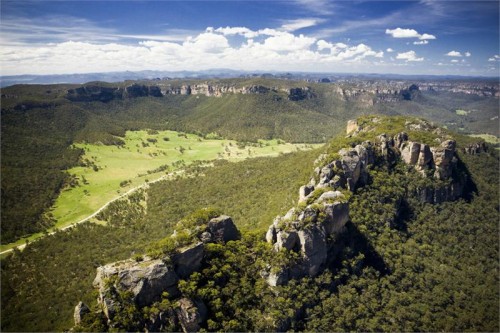 Gardens of Stone
© Photo by Hamilton Lund, Tourism NSW
Blue Mountains – Visit NSW, ^http://www.visitnsw.com/destinations/blue-mountains (click photo to enlarge) Gardens of Stone
© Photo by Hamilton Lund, Tourism NSW
Blue Mountains – Visit NSW, ^http://www.visitnsw.com/destinations/blue-mountains (click photo to enlarge)
.
The area embraces the last unprotected part of the 1934 Greater Blue Mountains National Park proposal compiled by Myles Dunphy for the National Parks and Primitive Areas Council. It also includes the Blue Mountains Western Escarpment lands from Blackheath to Lithgow. The Gardens of Stone Stage 2 proposal advanced by The Colong Foundation for Wilderness, the Blue Mountains Conservation Society and the Colo Committee is to include all of the remaining parts of Newnes Plateau and surrounding sandstone uplands – an area of 40,000 hectares. It would protect the most spectacular pagoda landscapes in Australia.
Associated with these pagoda landforms are found large caves, mazes, ancient montane heathlands, endangered upland swamps, snowgums, grassy woodlands and moist gullies that contain tree ferns, stands of old growth forest and rainforest, and, in some places, slot canyons.
Reservation of Stage Two would also secure the outstanding ochre coloured cliffs of the Blue Mountains’ Western Escarpment and the rare plant communities that lie above them. Reservation of the remaining unprotected parts of the Gardens of Stone as a State Conservation Area is urgently required to rein in ongoing and accelerating environmental degradation.
[Sources: Gardens of Stone National Park, http://www.worldheritage.org.au/resources/national-parks/gardens-of-stone-national-park/ and Blue Mountains Conservation Society, http://www.bluemountains.org.au/gos2.shtml]
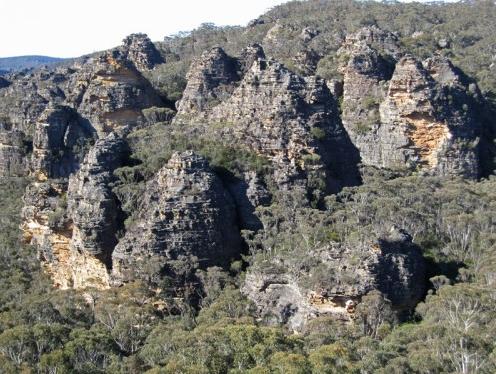 Pagodas of the Gardens of Stone (still outside the National Park) Pagodas of the Gardens of Stone (still outside the National Park)
© Photo by Andrew Valja
[Source: Blue Mountains Conservation Society, http://www.bluemountains.org.au/gos2.shtml]
(click photo to enlarge)
.
.
.

Threats from Coalpac Pty Ltd
.
CoalPac is a private Queensland coal mining company headquartered in Pullenvale in outer eastern Brisbane. In 1989, CoalPac took over coal mining operations outside the town of Lithgow in New South Wales, at the Cullen Valley Open Cut Mine and the Invincible Open Cut Mine. The Mines currently operate at 2 mtpa and Coalpac has plans for significant expansion of coal mines in the Gardens of Stone area.
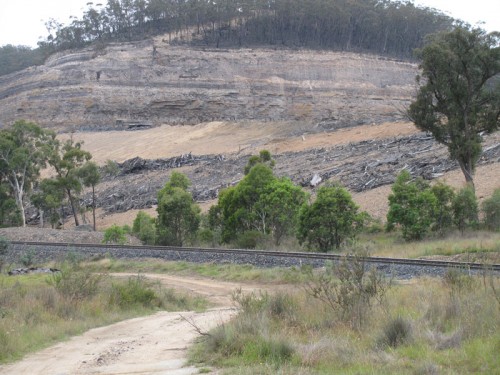 Coalpac’s CullenValley Mine
[Source: Lithgow Environment Group, Inc.]
(click photo to enlarge) Coalpac’s CullenValley Mine
[Source: Lithgow Environment Group, Inc.]
(click photo to enlarge)
.
‘Coalpac is seeking approval for the consolidation and expansion of the existing Cullen Valley Mine and Invincible Colliery operations to produce up to a total of 3.5 million tonnes per annum.’ [Source: http://cetresources.com/about-us]
This proposed extension of its open-cut and highwall mining will intrude into a large area of the publicly-owned Ben Bullen State Forest (BBSF), NSW. The extension area is equivalent of 2,176 football fields of predominantly old growth forest will be clear-felled and excavated if this goes ahead. The pagoda’s features and stability may be threatened by collapse.
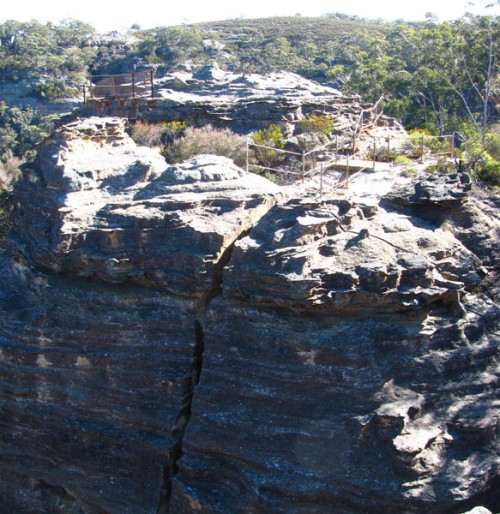 Cracked Hassans Walls, Lithgow ~ caused by nearby mining
[Source: Lithgow Environment Group, Inc.] Cracked Hassans Walls, Lithgow ~ caused by nearby mining
[Source: Lithgow Environment Group, Inc.]
.
“The NSW National Parks and Wildlife Service (now within the Office of Environment and Heritage) has acknowledged its wish to add BBSF to the conservation reserve system as a matter of priority” says Lachlan Garland, President of the Blue Mountains Conservation Society.
“Allowing this operation would mean the equivalent of 2,176 football fields of predominantly old growth forest of the BBSF being clear-felled and excavated.
“This forest is a publicly-owned area of conservation and recreational importance. The community expects state forests to be protected from destruction in perpetuity.
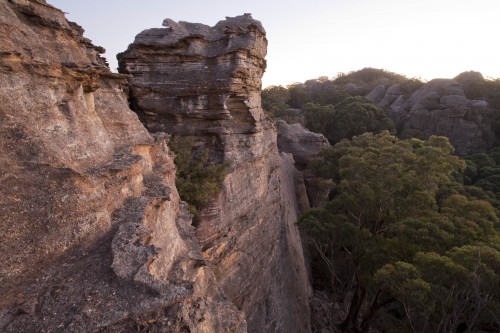 ‘Baal Bone Creek’ area at risk
©Photo by Ian Brown.
‘Baal Bone and Long Swamp (7,800 hectares) comprise massed pagoda ‘villages’ above the Long Swamp, a diverse swampy plain. They collectively form an evocative landscape of broken stone, reminiscent of Cambodia’s forest of State Forest temples, while nearby indigenous cave art honours this landscape.’
(click to enlarge, then click again to enlarge further) ‘Baal Bone Creek’ area at risk
©Photo by Ian Brown.
‘Baal Bone and Long Swamp (7,800 hectares) comprise massed pagoda ‘villages’ above the Long Swamp, a diverse swampy plain. They collectively form an evocative landscape of broken stone, reminiscent of Cambodia’s forest of State Forest temples, while nearby indigenous cave art honours this landscape.’
(click to enlarge, then click again to enlarge further)
.
“Habitats for the Regent Honeyeater, Tiger Quoll and Powerful Owl and at least 32 threatened native animals, 5 of which are listed under the EPBC Act, will be completely removed.
“Our iconic Lyrebirds also use the sides of pagodas to nest and raise their young. Mining will completely remove the protective pathways for adult birds foraging between nesting sites and will destroy their food habitats within the more fertile valley floors.
“The effective privatisation and liquidation of a large part of the forest is an outrageous precedent that should not be set; it is a direct challenge to the state’s efforts to reduce deforestation.
“The Blue Mountains Conservation Society seeks to work with the Minister for the Environment and Heritage, Robyn Parker, to continue our important work and safeguard the future of the Gardens of Stone.
“We invite all politicians to visit the Gardens of Stone area with us on Sat 14th May, 2011 to see first hand the stunning areas under threat from mining.”
The NSW Department of Planning finalised the Director-General’s Requirements (guidelines) for the Environmental Assessment on 16 October 2010. The proponent is preparing the Environmental Assessment. Once finalised, this will be released for public comment. The project, prior to the election of the NSW Coalition Government, was to be assessed by an accredited process under Part 3A, which on 7th April 2011 was scrapped by the incoming O’Farrell Liberal Government of New South Wales. [read article below]
 The very yellow Pagoda Daisy (at risk)
©Photo by Ian Brown
(click to enlarge, then click again to enlarge further) The very yellow Pagoda Daisy (at risk)
©Photo by Ian Brown
(click to enlarge, then click again to enlarge further)
.
Environment groups take action to protect Gardens of Stone
The uniquely scenic and biodiverse Gardens of Stone is under imminent threat due to a consolidation proposal by Coalpac Pty Ltd. If approved, wildlife habitat and natural heritage will be lost forever, water systems will be stressed and there would be direct impacts for local residents. On Saturday 14th May, 2011 environment groups and their supporters will be taking action to help protect this iconic landscape from irredeemable destruction.
“Coalpac Pty Ltd seeks to extend open-cut and highwall mining into a large area of the publicly-owned Ben Bullen State Forest, NSW. The NSW National Parks and Wildlife Service has acknowledged its wish to add this forest to the conservation reserve system as a matter of priority” says Tara Cameron, Vice President of Blue Mountains Conservation Society.
“Many of the highwall scarps will abut strata directly below the ‘pagoda’ rock formations, their features and stability may be threatened by collapse. Environment groups are outraged at this proposal” says Tara Cameron.
“This forest is a publicly-owned area of conservation and recreational importance. The community expects state forests to be protected from destruction in perpetuity. If the NSW Government’s Strategic Regional Landuse Policy is to mean anything for sensitive, natural lands, then the Gardens of Stone must be protected from destructive mining operations, ” says Keith Muir, Director of Colong Foundation for Wilderness.
“This landscape is biodiversity hotspot, characterised by rich old-growth forests. Our iconic Lyrebirds use the sides of pagodas to nest and raise their young. Mining will completely remove their food habitats as well as the habitats of at least 32 threatened native animals” says Belinda Fairbrother, Campaigns Manager for The Wilderness Society NSW.
“Water management and impacts over such a large, exposed open-cut area are of great concern. The large open cut will also create significant dust and air quality issues which will impact directly on local residents” says Caroline Graham, Vice President of Rivers SoS.
“Environment groups are calling on the government to reject this mining proposal and act to protect the region within a State Conservation Area. We are coming together at this event to send a clear message that ‘We say No to open cut mining!’ in this iconic area of our state” says Kevin Evans, EO of National Parks Association of NSW.
“Across NSW, areas of high conservation value and great beauty are under threat from the rapid expansion of the coal and coal seam gas industries. During this time of transitional arrangements on the regulation of coal mining, the State government has an opportunity to deliver on its promise of better protection of water resources and the environment by rejecting further mining at the iconic Gardens of Stone,” says Pepe Clarke, CEO of the Nature Conservation Council of NSW.’
[Source: National Pars Association of NSW, http://www.npansw.org.au/index.php?option=com_content&view=article&id=718:environment-groups-take-action-to-protect-gardens-of-stone&catid=172:2011&Itemid=564]
.
.
‘Part 3A scrapped’
[8 Apr 11, by Tyron Butson, Southern Courier newspaper, http://southern-courier.whereilive.com.au/news/story/part-3a-scrapped/]
PREMIER Barry O’Farrell has given increased planning powers back to local councils after scrapping the controversial Part 3A amendment.
He announced the decision to drop Part 3A of the 1979 Environmental Planning and Assessment Act at yesterday’s first State Cabinet meeting.
Local councils will now have final say on many outstanding applications, while others will be referred to the NSW Planning Assessment Commission.
No new Part 3A application for residential, commercial, retail or coastal development will be accepted and the State Government hope to push through legislation that will see the amendment repealed from the Statute books when Parliament resumes.
“This means a return of planning powers to councils and local communities,” Mr O’Farrell said.
“The days of giving the Planning Minister sweeping powers to approve developments at the stroke of a pen with virtually no consultation with local communities are over.
“That extreme power only leads to the sort of suspicion and shady deals we have seen in NSW over the past 16 years.”
The scrapping of Part 3A was a core election promise of the Liberal party, but the government will still have to push legislation through the Upper House.
Mr O’Farrell said he had not attempted to convince opposition members but had directed the Minister for Planning Brad Hazzard to draw up plans.
Until then transitional arrangements will be put into place to deal with more than 500 Part 3A applications already in the system.
About half of the applications will now face the Planning Assessment Commission for assessment, while the rest will either be sent to local councils to vote on or allowed to lapse.
Part 3A was introduced in 2005 and gave planning ministers the ability to overrule local councils and communities on any project the minister deemed to be of state or regional importance.’
.
.
‘Cliffs crumbled due to coal mining, says new report’
(by Ben Cubby, Environment Editor, Sydney Morning Herald, April 27, 2010)
‘DOZENS of cliffs have crumbled or collapsed, Aboriginal rock art has been destroyed and metre-wide cracks opened in the earth as a result of coalmining in the Gardens of Stone wilderness area near Lithgow, an independent report has found.
The damage, inflicted over three decades by five coal mines and continuing today, is caused by subsidence from longwall mining, which now almost surrounds the Gardens of Stone National Park, part of the Greater Blue Mountains World Heritage Site. It is likely to be extended further if a new mine plan is approved by the NSW government.
The report, to be launched today by the former premier Bob Carr, documents wide-scale, unpublicised damage, including the destruction of some of the area’s unique sandstone pagodas and rock arches.
”In its monitoring reports to government, the coal industry regularly understates the damage caused,” said Keith Muir, the executive officer of the Colong Foundation for Wilderness, which produced the report. ”Mine operations do not work to minimise environmental damage and have been largely unresponsive to environmental concerns.”
The study based this conclusion on visual observation in the remote bushland and examination of the the environmental assessments used to justify the expansion of mining. In some cases, the assessments predicted that cliffs could crumble but no remedial action was taken.
The report looks at the six coalmines around the national park: the Angus Place, Springvale and Airly mines operated by Centennial Coal, Baal Bone and Clarence collieries operated by Coalex, and Invincible mine, operated by Coalpac. All the mining companies have met the requirements of their environmental assessment processes and have continued to monitor the impact of subsidence.
Reports produced by consultants employed by the companies showed more than 100 recorded cliff falls in the past three decades. Some led to changes in sites and techniques, but in the majority of cases the warnings were not heeded.
The damage was significantly worse above longwall mines, which cut out long, broad panels of coal, leaving the surface above to crack and subside. The Clarence and Airly mines use the bord and pillar technique, which involves leaving more coal in the ground to support the rock above, resulting in less surface damage.
Aboriginal rock art sites were also photographed with major fractures running through them and, in some cases, entire rock faces destroyed by the effects of subsidence.
”Crevasses, cliff falls and rock fractures are spoiling the sandstone beauty of the Gardens of Stone,” Mr Muir said.
The organisation is calling for a state-sanctioned conservation area that would provide a buffer zone around the park. It would cover part of the Baal Bone mine area, where a further expansion is planned, and the Newnes Plateau, where many swamps have been drained when the rock beneath them cracked open.
”The Department of Environment, Climate Change and Water has been considering proposals for additions to the Gardens of Stone National Park and an evaluation process is under way,” a spokeswoman said.
Read more: http://www.smh.com.au/environment/cliffs-crumbled-due-to-coalmining-says-new-report-20100426-tnbk.html#ixzz1MGS62mRx
.
.
Previously in 2007…
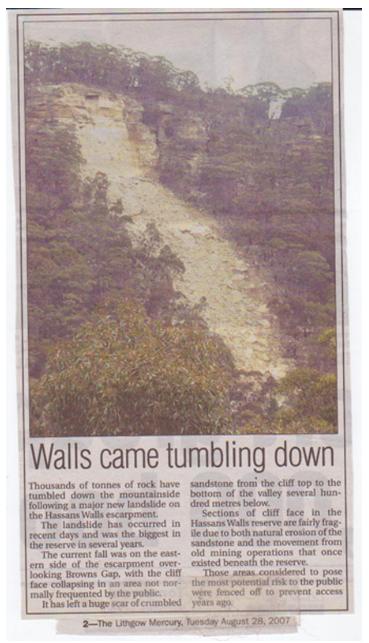
.
.
Further Reading:
.
[1] Previous article on this website: ‘Gardens of Stone at Risk from Coal Mining’, > https://www.habitatadvocate.com.au/?p=4021
[2] Blue Mountains Conservation Society, ^http://www.bluemountains.org.au/gos2.shtml
[3] Gardens of Stone National Park, ^http://www.worldheritage.org.au/resources/national-parks/gardens-of-stone-national-park/
[4] The Colong Foundation for Wilderness, ^ http://www.colongwilderness.org.au/Gardens_of_Stone/GoS2_home.htm
[5] Lithgow Environment Group, Inc. ^http://www.lithgowenvironment.org/mine_watch.html
[6] Lithgow Tourism, ^http://www.lithgow-tourism.com/gardenstone.htm
[7] Rivers SOS, ^http://riverssos.org.au/2011/04/27/help-us-protect-the-gardens-of-stone/
[8] National Parks Association of NSW, ^http://www.npansw.org.au/index.php?option=com_content&view=article&id=718:environment-groups-take-action-to-protect-gardens-of-stone&catid=172:2011&Itemid=564
[9] ‘Cliffs crumbled due to coalmining, says new report’, by Ben Cubby, Sydney Moring Herald, April 27, 2010, ^http://www.smh.com.au/environment/cliffs-crumbled-due-to-coalmining-says-new-report-20100426-tnbk.html

– end of article –
Environment groups take action to protect Gardens of Stone
The uniquely scenic and biodiverse Gardens of Stone is under imminent threat due to a consolidation proposal by Coalpac Pty Ltd. If approved, wildlife habitat and natural heritage will be lost forever, water systems will be stressed and there would be direct impacts for local residents. On Saturday 14th May, 2011 environment groups and their supporters will be taking action to help protect this iconic landscape from irredeemable destruction.
“Coalpac Pty Ltd seeks to extend open-cut and highwall mining into a large area of the publicly-owned Ben Bullen State Forest, NSW. The NSW National Parks and Wildlife Service has acknowledged its wish to add this forest to the conservation reserve system as a matter of priority” says Tara Cameron, Vice President of Blue Mountains Conservation Society.
“Many of the highwall scarps will abut strata directly below the ‘pagoda’ rock formations, their features and stability may be threatened by collapse. Environment groups are outraged at this proposal” says Tara Cameron.
“This forest is a publicly-owned area of conservation and recreational importance. The community expects state forests to be protected from destruction in perpetuity. If the NSW Government’s Strategic Regional Landuse Policy is to mean anything for sensitive, natural lands, then the Gardens of Stone must be protected from destructive mining operations, ” says Keith Muir, Director of Colong Foundation for Wilderness.
“This landscape is biodiversity hotspot, characterised by rich old-growth forests. Our iconic Lyrebirds use the sides of pagodas to nest and raise their young. Mining will completely remove their food habitats as well as the habitats of at least 32 threatened native animals” says Belinda Fairbrother, Campaigns Manager for The Wilderness Society NSW.
“Water management and impacts over such a large, exposed open-cut area are of great concern. The large open cut will also create significant dust and air quality issues which will impact directly on local residents” says Caroline Graham, Vice President of Rivers SoS.
“Environment groups are calling on the government to reject this mining proposal and act to protect the region within a State Conservation Area. We are coming together at this event to send a clear message that ‘We say No to open cut mining!’ in this iconic area of our state” says Kevin Evans, EO of National Parks Association of NSW.
“Across NSW, areas of high conservation value and great beauty are under threat from the rapid expansion of the coal and coal seam gas industries. During this time of transitional arrangements on the regulation of coal mining, the State government has an opportunity to deliver on its promise of better protection of water resources and the environment by rejecting further mining at the iconic Gardens of Stone,” says Pepe Clarke, CEO of the Nature Conservation Council of NSW.
Tags: Baal Bone, Barry O'Farrell, Ben Bullen State Forest, Blue Mountains World Heritage Area, Capertee Valley, Coal Mining, Coalpac Pty Ltd, Gardens of Stone, Genowlan Mountain, Hassans Walls, Lithgow Coal, Minister for Planning Brad Hazzard, Minister for the Environment and Heritage Robyn Parker, Newnes Plateau, Pantoneys Crown, Part 3A, Powerful Owl, Regent Honeyeater, Tiger Quoll, Wolgan Valley
Posted in Blue Mountains (AU), Threats from Mining | No Comments »
Add this post to Del.icio.us - Digg
Wednesday, January 26th, 2011
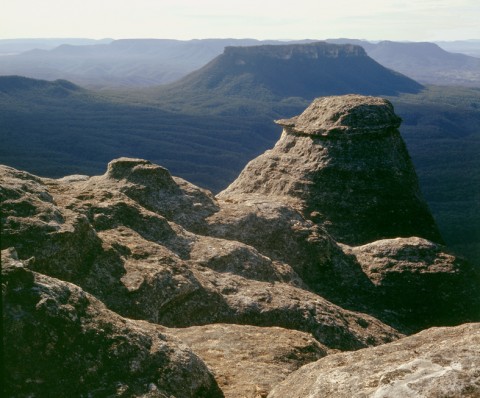 Capetree Valley looking toward Pentoney’s Crown,
Gardens of Stone NP
Blue Mountains region, New South Wales, Australia
© Photo by Henry Gold, wilderness photographer Capetree Valley looking toward Pentoney’s Crown,
Gardens of Stone NP
Blue Mountains region, New South Wales, Australia
© Photo by Henry Gold, wilderness photographer
.
Gardens of Stone is a national park in the Australian state of New South Wales, 125 km northwest of Sydney. At 15,010 ha it is part of the Greater Blue Mountains Area World Heritage Site. [Wikipedia]
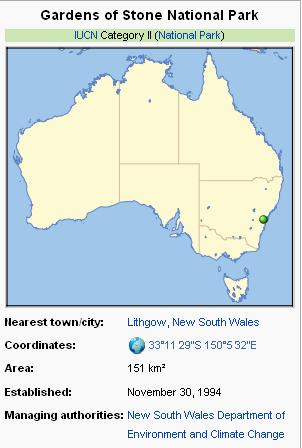
.
Yet much larger and similarly high conservation areas featuring pagodas of the Gardens of Stone and other incredibly rare natural landscapes and ecosystems lie adjacent to this national park. Similar rugged natural areas adjoining the Gardens of Stone National Park span some additional 40,000 hectares, featuring rare and magnificent sandstone escarpments, ancient natural pagodas and plateau country of the north western Blue Mountains – a natural part of the declared Greater Blue Mountains World heritage area park system.
Read below to learn more about proposed protection ‘Stage Two’ …
.
.
The Gardens of Stone Park Proposal Stage Two
.
Joint Media Release 28 November, 2005 by Colong Foundation for Wilderness, Blue Mountains Conservation Society and the Colo Committee:
.
‘Today the Colong Foundation for Wilderness, the Blue Mountains Conservation Society and the Colo Committee launched a new proposal to protect 40,000 hectares. The proposal, centred on the township of Lithgow, is called the Gardens of Stone.
“The Gardens of Stone area is scenically, environmentally and historically unparalleled. Its current low level of protection shows a scandalous disregard of this magnificent heritage. The Gardens of Stone proposal is an innovative approach that will ensure better protection of these unparalleled areas and greatly enhance tourism in the western Blue Mountains-Lithgow region”, said Dr Brian Marshal, President of the Blue Mountains Conservation Society.
“’This area for too long has been taken for granted, yet is truly a national gem. Its geology is dramatic and spectacular, its biodiverisity is fascinatingly diverse, and its cultural history is extensive. It is time at last for the overlooked to be valued and acknowledged. This is a fantastic area that truly deserves reserve status!”, said Haydn Washington, Secretary of the Colo Committee.
“The Gardens of Stone is a place worth saving that has great potential for quiet, family-based recreation. The proposed system of new Gardens of Stone parks will greatly enhance tourism opportunities in the central and western Blue Mountains around Lithgow,” said Keith Muir, director of the Colong Foundation for Wilderness.
The Gardens of Stone has iconic heritage of national significance. The park proposal aims to protect and manage:
- the first three rugged mountain passes west to the interior of Australia;
- the outstanding Aboriginal cultural sites on and around Newnes Plateau;
- the wonderful oil shale mining ruins on spectacular Airly Mesa;
- some of the highest plant diversity in the Blue Mountains; and
- some of the most beautiful and intricate sandstone formations in Australia.
.
“The plant, animal and Aboriginal heritage of the proposal reflect the landscape’s diversity. The proposal’s many rare plants, unique snowgrass-snowgum woodlands, shrub swamps and heathlands are not protected elsewhere, said Mr Washington.
“The Gardens of Stone is a geological wonderland of coloured escarpments, narrow canyons, rock arches, cave overhangs, lonely sandstone peninsulas and remnant forested sand dunes from the last ice age”, Dr Marshall said.
Mr Muir believes that “Heritage-based tourism could draw Lithgow toward a more environmentally sustainable future”.
“The proposal provides an integrated plan of action to protect, manage and interpret the area but recognises the realities of existing coalmining operations”, he added.
[Source: http://www.colongwilderness.org.au/media_releases/media_archive05.htm#MR05112800]
.
.
The following article is that by Ian Brown of the Colong Foundation for Wilderness which may be located under the heading ‘Seeing the Gardens by Ian Brown.’ It is based upon a report on the recreational and tourism potential of the Gardens of Stone Stage 2 park proposal, jointly commissioned by the Blue Mountains Conservation Society and the Colong Foundation.)
.
‘The Gardens of Stone Park Proposal Stage Two (GoS2) was launched by the Colong Foundation in 2005. It covers an area of 40 000 hectares of sandstone escarpment and plateau in the western Blue Mountains , on the western side of the existing Greater Blue Mountains World heritage area park system. The proposal takes in parts of the upper Capertee Valley , Coxs River headwaters, Turon River headwaters, Newnes Plateau and Blue Mountains western escarpment.
The objective of the GoS2 proposal is to achieve better management and protection of this area’s many important natural and cultural values. The GoS2 park system is proposed to be a mixture of state conservation area (SCA) and national park tenure. SCA status allows underground coal mining to continue.
The GoS2 area’s outstanding conservation values have been well documented in the Colong Foundation’s The Gardens of Stone Park Proposal Stage Two (October 2005). There is no doubt that the area’s scenery and heritage can also offer a diverse range of low impact recreational activities attracting significant visitor numbers, thus expanding the local tourism industry. One purpose of the current study was to show that GoS2 can deliver significant economic benefits to local communities.
.
An under-valued landscape
.
‘GoS2 offers the part of the Gardens of Stone landscape that is easily accessed and enjoyed by the general public. The nearby parks offer similar features and experiences, but they tend to be accessible to visitors with bush skills due to more rugged topography. GoS2, which is largely of more subdued terrain, brings the unique landscape of the Gardens of Stone to the majority of people.
This article will focus on the northern sectors that make up most of the proposal and which have the greatest potential for improved conservation and recreation management. These include the Airly-Genowlan mesas and Ben Bullen, Wolgan and Newnes State Forests. The other main sector, the western escarpment Crown reserves extending from Hassans Walls at Lithgow to Medlow Bath, is already well developed for recreation with increasingly effective management by local councils.
But the existing management regime over Airly-Genowlan and the state forests can best be characterised as lassez faire in relation to recreation and relatively passive in relation to conservation. The dominant land uses of coal mining and forestry have led to a devaluation of the important natural and cultural heritage values of the area in the public mind. Off-road vehicle activity, particularly trail bike riding, has been allowed by neglect to become the dominant recreation, even though most of it is illegal (unregistered vehicles, unlicensed riders and creating new tracks). This has further alienated less damaging activities such as walking, which mainly takes place on the fringes of the plateaus.
The GoS2 area has not yet been presented or promoted to the public as a great place to enjoy a remarkable landscape. Hence, the strong potential of the GoS2 area for low-impact, nature-based recreation and tourism has been under recognised and under-utilised.”
.
A better future
.
‘This can be changed by implementing the GoS2 reserve proposal and advancing a recreation and tourism plan for the area. With the right presentation and promotion, environmentally benign recreational use of GoS2 can be expanded dramatically.The natural and cultural attractions are many, varied, widespread across the area and highly appealing. Some features (e.g. Lost City , Carne Creek gorge, new Hartley mining heritage, Wolgan Valley Rail Trail) have the potential to become iconic attractions. A number of easy wildlife viewing opportunities exist and several Aboriginal heritage experiences are available.
This alternative vision presents an existing network of touring routes for motor vehicles and bicycles, accessing a range of potential camping areas, bushwalks, lookouts and cultural and wildlife experiences. Most of the proposed places of interest can be linked into a ‘Gardens of Stone Grand Tour’ which could be taken over one to three days by 4WD vehicle or mountain bike.
Although providing for these recreational activities will have some localised impacts, a number of already-disturbed sites can be utilised. Furthermore, the likely impacts are minor when compared to the existing and future impacts of the current recreational regime.
The current controversy over government plans to expand private tourism development within national parks has been taken into account, and the GoS2 plan seeks to demonstrate how low-key, low impact visitor facilities can provide the backbone of local tourism without damaging the parks with accommodation and similar developments.
The proposed network of visitor experiences would provide the basis of a whole new nature-based marketing initiative for the western Blue Mountains, promoting the Gardens of Stone as the very distinctive other side of the Blue Mountains. Just two hours from Sydney and with all the services any visitor could need in adjacent towns, GoS2 could become an iconic venue for campers, bushwalkers, tourers, cyclists and nature and heritage enthusiasts. The suite of opportunities creates a sound basis for commercial tourism enterprises such as guided tours and local off-park accommodation.
Such a future could realise significant economic opportunities through visitor expenditure, and for both specialised services (tours, eco-accommodation) and more general commercial activity in the surrounding area.”
.
Economic benefits
.
Estimating tourism to protected areas and resultant economic benefits can be difficult. Based on comparable statistics and studies from NSW, Queensland and Victoria, a conservative upper estimate for tourism to a GoS2 park with the proposed facilities is 50,000 visitors a year. This level of tourism activity has been estimated to produce substantial net benefits to the community in the order of $28M to $38M, depending on the discount rate used. These net benefits may represent a minimum value since management costs savings to Forests NSW have not been able to be included and the levels of timber production and royalties assumed may be conservatively high.The regional economic benefit produced by 50,000 visitors to GoS2 is estimated as a direct spend of around $3M to $4M. Over and above this would be expenditure on park management, and the expansion of commercial tour activities and the establishment of new visitor accommodation in nearby areas which is likely to follow.
The case for protecting the GoS2 lands for both conservation and direct community benefit is strong. It is now up to the NSW Government to do it.’
.
[Source: http://www.colongwilderness.org.au/features.htm]
.
.
But the Gardens of Stone are being destroyed by Centennial Coal
.
The magnificent rugged and rare geomorphology and high plateau ecosystems of the Bkue Mountains region is under serious irreverible threat of destruction by coal mining. The natural heritage values of the Gardens of Stone are being impacted by coal mining, causing bedrock subsidence, longwall mining is cracking the creekbeds and mine effluent pumping are destroying the natural groundwater acquifers. The rare geodiversity is being destroyed as Centennial Coal’s mining at Angus Place Colliery and Baal Bone Colliery cause cliff falls.
Aboriginal heritage rock art is being fractured. Creeks, rivers and upland swamps such as East Wolgan Swamp are being polluted by heavy metals from Centennial Coal’s mines. The mining is causing surface subsidence, stream flows are disappearing in Kangaroo Creek and the Wolgan River
A media release by the Colong Foundation for Wilderness 27 April 2010, highlighted current threats posed by Coal Mining:
The Gardens of Stone – a story to break the hardest heart
‘Imagine, New South Wales has its very own Bungle Bungle Range just 2½ hours from Sydney on the western edge of the Blue Mountains. It is a place of superlative scenery and tremendous botanical diversity. Today the Colong Foundation reveals that this little known wonderland called the Gardens of Stone may soon be spoiled if high impact coal mining is not curbed..“The Colong Foundation’s recent report (The impact of coal mining on the Gardens of Stone) documents how the coal industry’s environmental record is being etched and caved onto the Gardens of Stone landscape,” said Keith Muir Director of the Colong Foundation for Wilderness.
“Coal mining has:
- Caused several hundred cliff collapses in the most beautiful part of the Blue Mountains;
- Monitored these cliffs falls for 30 years, rather than acted to reduce the damage;
- Turned (nationally endangered) swamps to dust by cracking near-surface aquifers;
- Poisoned (nationally endangered) swamps with eco-toxic mine effluent;
- Turned the Wolgan River red;
- Claimed an environmental award for providing dirty, saline mine effluent to a power plant that shortly afterwards required a major repairs to its condensers costing tens of millions of dollars;
- Blighted the landscape with a network of roads, pipes, survey lines and power lines;
- Polluted drinking water supplies for Lithgow with nickel.
.The list goes on”, Mr Muir said.“In its monitoring reports to government the coal industry regularly understate the damage caused,” he said. “Mine operations do not work minimise environmental damage and have been largely unresponsive to environmental concerns”, he added.
“Crevasses, cliff falls and rock fractures are spoiling the sandstone beauty of the Gardens of Stone. Yet despite the intense study of mine subsidence for 30 years, the natural geomorphological processes that control cliff falls are not understood”, said Mr Muir.
“The Gardens of Stone in NSW is as spectacular as the Bungle Bungle Ranges, with a far greater floristic diversity. It must not be needlessly degraded by coal mining, as it can be preserved for everyone to enjoy,” Mr Muir said.
The damage can be curbed by reducing mining intensity. Taking such action would actually employ more miners and save this outstanding environment. One colliery has reduced its mining intensity, and a new one is about to start that will be far less damaging than previous operations. The State and Federal Governments should step in to protect from further damage the nationally endangered shrub swamps, the streams, cliffs and the sandstone pinnacles called pagodas that make up this natural wonderland”, Mr Muir said.
.
.
.
New mining prospect for Capertee
[Article from the local newspaper, The Lithgow Mercury, 20080705]
.
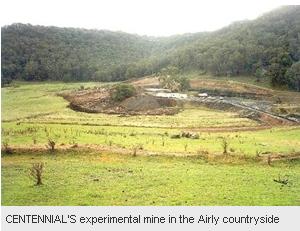
‘The Capertee community could benefit from a significant economic boost in the near future, including the direct creation of 80 jobs, if Centennial Coal’s Airly Project proceeds. Airly is an 80 million tonne coal resource located approximately 3 km north east of the Capertee township and is a project acquired by Centennial Coal in 1997 with an existing planning consent (originally granted in 1993).
There had been previous activity on the site including underground mining to obtain a bulk sample and verify mining conditions. Further work required to establish a trial mine commenced in April 1998. A Trial Mine Phase commenced in December 1998 when about 70,000 tonnes of coal was extracted over a 12 month period. An access road and other surface works were also completed.
“Lately, locals will have noticed an increase in traffic movement around Airly as a variety of visitors to the site complete studies, update data and review planning and engineering options for the site,” Centennial’s General Manager: Projects, Richard Tacon said.
“The proposed mine design would include the construction of a rail loading facility to ensure all coal from the site can be transported by rail.
“We anticipate the internal assessment process will be finalised over the next few months placing Centennial in a position to formalise a decision to proceed with the project,” Mr Tacon said.
“If Centennial does decide to proceed with this project, we will inform the community, place an utmost priority on minimising environmental impacts and strictly comply with the appropriate planning laws.”
[Source: http://www.lithgowmercury.com.au/news/local/news/general/new-mining-prospect-for-capertee/804919.aspx ]
.
.
.
Wolgan Road Project
.
On Centennial Coal’s website, under ‘Operations’ there is mention of a proposed Wolgan Road Project to be located within the Angus Place Colliery Lease. The project area is approximately 14km northwest of Lithgow, approximately 5km to the east of Mount Piper Power Station and 4km north of Wallerawang Power Station.
The area contains a small shallow coal resource between the underground workings of Wallerawang and Angus Place, with an estimated mine reserve of approximately 4.9 million tonnes, recoverable by open cut methods. Further detailed work including geotechnical investigations, environmental management assessment, community consultation and detailed mine planning would need to be completed before the requisite approvals could be sought.
[Source: http://www.centennialcoal.com.au/index.php?option=com_content&view=article&id=46&Itemid=54, accessed 20110126]
Sounds inoccuous enough, except that the Angus Place Colliery Lease is not ‘north west‘, but north of Lithgow. This places it within the Wolgan River catchment in sensitive escarpment country within the proposed Gardens of Stone NP Stage Two.
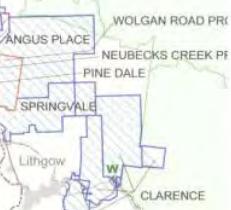 Map from the 2008 NSW Coal Industry Profile.
. Map from the 2008 NSW Coal Industry Profile.
.
.
Centennial Coal’s Environmental Claims
.
Centennial Coal on its website under the heading of ‘Environmental Management‘ claims that Centennial’s Directors and Management are:
“committed to continual improvement in environmental and community management and performance.”
Centennial recognises the importance of effectively managing the environmental impacts associated with each mine and, over the years, has developed an Environmental Policy that commits the Company to continual improvement in its environmental management and performance.
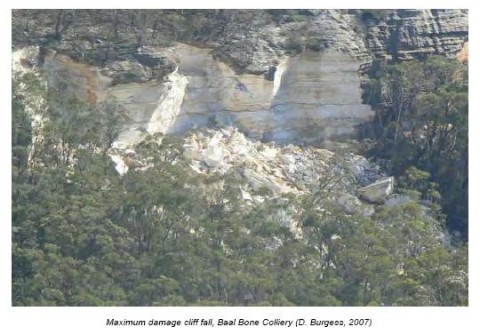 ‘Impact of Coal Mining on the Gardens of Stone’
©2010 Colong Foundation for Wilderness ‘Impact of Coal Mining on the Gardens of Stone’
©2010 Colong Foundation for Wilderness
.
CENTENNIAL COAL’S VISION
“To conduct our business in an efficient and environmentally responsible manner, that is compatible with the expectations of our Shareholders, government, employees and the community.”
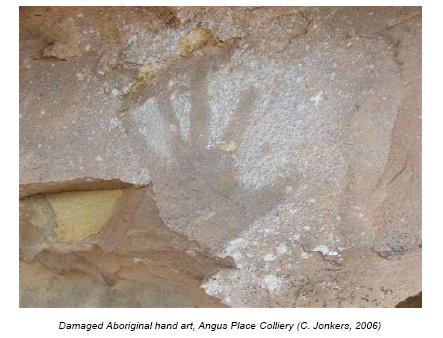 ‘Impact of Coal Mining on the Gardens of Stone’
©2010 Colong Foundation for Wilderness
.
. ‘Impact of Coal Mining on the Gardens of Stone’
©2010 Colong Foundation for Wilderness
.
.
CENTENNIAL COAL’S GUIDING PRINCIPLES FOR ENVIRONMENTAL MANAGEMENT
.
1. Appropriate decisions are made
2. Risk management strategies are implemented based on clear science and valid data
3. Stakeholders are identified and respected
4. Environmental impacts are recognised and minimised
5. Legal obligations are known and respected
6. Environmental management is integrated into our business
7. Environmental performance is continually improved
8. Natural resources are used efficiently
9. Performance is assessed and reported
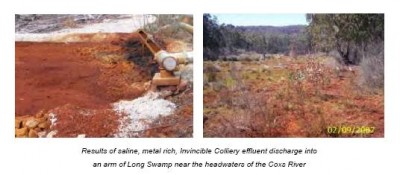 ‘Impact of Coal Mining on the Gardens of Stone’
©2010 Colong Foundation for Wilderness
.
. ‘Impact of Coal Mining on the Gardens of Stone’
©2010 Colong Foundation for Wilderness
.
.
The Centennial Environmental Vision and logo designed to assist in raising the awareness and visibility of the group’s environmental effort, seeks to deliver two messages:
- Firstly, that the environment matters to Centennial, ie it is a fundamental part of Centennial’s business; and
- Secondly, environmental matters, or elements of the biophysical environment (air, plants and animals, ground/soil and water) that sustain society can be affected by Centennial’s activities if not appropriately managed
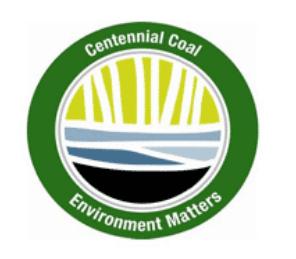
‘In a “branding” sense, the motto ” environment matters” is designed to be a distinctive reminder of Centennial’s aims and commitments.’
[Source: http://www.centennialcoal.com.au/index.php?option=com_content&view=article&id=4:environmental-management&catid=10:who-we-are&Itemid=12]
Such is this company’s calculated greenwashing
to the extent of strategic misinformation,
so long as it exploits,
scams impunity from its heavy metal contamination,
inflicts irreversible bedrock subsidence….
Somehow justified by
‘temporary jobs, temporary jobs, temporary jobs’.
.
 …an ethical investment?
.
…an ethical investment?
.
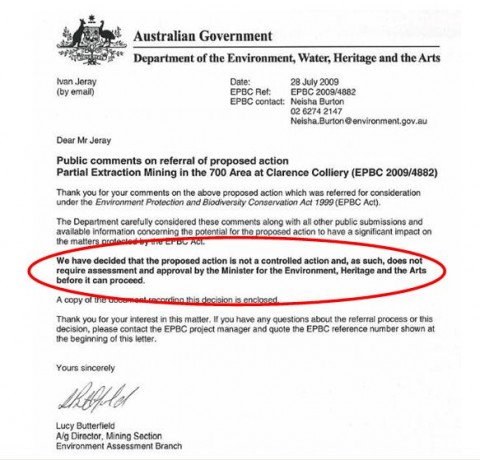
.
Further Reading:
.
[1] Gardens Of Stone Stage 2 Proposal, ^http://bluemountains.org.au/gos2.shtml
.
[2] The Impact of Coal Mining on the Gardens of Stone [ read full publication],
http://www.colongfoundation.org.au
.
[3] Gardens of Stone National Park – Draft Plan of Management [ read full publication]
http://www.environment.nsw.gov.au/resources/parks/PoMDraftGardensOfStoneNP.pdf
.
[end of article]
.
Tags: Airly mine, Airly-Genowlan mesas, Angus Place Colliery, Baal Bone Colliery, Banpu, Ben Bullen State Forest, Blue Mountains Conservation Society, Blue Mountains western escarpment, Blue Mountains World Heritage Area, Capertee Valley, Carne Creek Gorge, Centennial Coal, Centennial Coal’s Airly Project, Clarence Colliery, Coal Mining, Coalex Pty Ltd, Coalpac Pty Ltd, Colong Foundation for Wilderness, Coxs River headwaters, DECCW, Gardens of Stone, Gardens of Stone National Park, Gardens of Stone Park Proposal Stage Two, GoS2, Hassans Walls, Henry Gold, Kores Aust. Pty Ltd, Lost City, Newnes Plateau, SK Corporation Pty Ltd, Springvale Colliery, Sydney Catchment Authority, Turon River headwaters, Wolgan River pollution, Wolgan Valley Rail Trail
Posted in 07 Habitat Conservation!, Blue Mountains (AU), Threats from Mining | 1 Comment »
Add this post to Del.icio.us - Digg
|
|
 Lessons from coal mining destruction of the Appalachian Mountains and its people
Lessons from coal mining destruction of the Appalachian Mountains and its people A Dickensian Industry
[Source: The 2012 London Olympics, ^http://www.mirror.co.uk/news/uk-news/london-2012-opening-ceremony-opinion-1176668]
A Dickensian Industry
[Source: The 2012 London Olympics, ^http://www.mirror.co.uk/news/uk-news/london-2012-opening-ceremony-opinion-1176668]
 Deadly Coal Dust
Deadly Coal Dust
 Hunter Valley Coal Train
[Source: Photo by Vince Wang
^http://www.railpage.com.au/f-t11342636-s30.htm]
Hunter Valley Coal Train
[Source: Photo by Vince Wang
^http://www.railpage.com.au/f-t11342636-s30.htm]
 Coal mining in NSW’s Hunter region co-exists with wine growing, racehorse breeding, dairy and other pastoral industries.
[Photo by Jo Schmaltz].
Coal mining in NSW’s Hunter region co-exists with wine growing, racehorse breeding, dairy and other pastoral industries.
[Photo by Jo Schmaltz].
 Dust clouds the view of the Ulan Mine conveyor belts
(North west of Mudgee, NSW)
Dust clouds the view of the Ulan Mine conveyor belts
(North west of Mudgee, NSW)
 <<‘Black Lung’ is a legal term describing a preventable, occupational lung disease that is contracted by prolonged breathing of Coal Mine Dust. Described by a variety of names, including:
<<‘Black Lung’ is a legal term describing a preventable, occupational lung disease that is contracted by prolonged breathing of Coal Mine Dust. Described by a variety of names, including: Protesters on horseback take to the streets in November 2009 to voice concerns over the proposed Bickham coal mine (Hunter Valley)
Friends of the Earth Sydney congratulates Pages River and Tributaries Water Users Association and Rivers SoS Alliance in their successful campaign to stop the proposed Bickham open-cut coal mine and save the Pages River (near Scone in the NSW Hunter Valley).
Protesters on horseback take to the streets in November 2009 to voice concerns over the proposed Bickham coal mine (Hunter Valley)
Friends of the Earth Sydney congratulates Pages River and Tributaries Water Users Association and Rivers SoS Alliance in their successful campaign to stop the proposed Bickham open-cut coal mine and save the Pages River (near Scone in the NSW Hunter Valley). CNA Coal, Muswellbrook
Hunter Valley
CNA Coal, Muswellbrook
Hunter Valley
 .
. Government vested interest in Coal Mining
‘In 2008-09 the royalty revenue generated by the NSW minerals sector was $1.28 billion, with coal accounting for approximately 95% of the total.’
[Source: New South Wales Government, Division of Resources and Energy – Minerals and Petroleum,
^http://www.resources.nsw.gov.au/resources/royalty, website accessed 20121111]
Government vested interest in Coal Mining
‘In 2008-09 the royalty revenue generated by the NSW minerals sector was $1.28 billion, with coal accounting for approximately 95% of the total.’
[Source: New South Wales Government, Division of Resources and Energy – Minerals and Petroleum,
^http://www.resources.nsw.gov.au/resources/royalty, website accessed 20121111]
 .
. Sour taste … Ruby Marshall (age 12), and her sister April (age 11)
Display an anti-mining sign at their lemon stall in the former farming village of Wollar
(Photo by Peter Rae)
Sour taste … Ruby Marshall (age 12), and her sister April (age 11)
Display an anti-mining sign at their lemon stall in the former farming village of Wollar
(Photo by Peter Rae)
 .
. Jason and Belinda Passlow with children Harrison, Lachlan and William in Bulga (Hunter Valley)
(Photo by Waide Maguire, The Daily Telegraph)
Jason and Belinda Passlow with children Harrison, Lachlan and William in Bulga (Hunter Valley)
(Photo by Waide Maguire, The Daily Telegraph)
 Goals Coal Plant in WV, owned by Massey Energy
Goals Coal Plant in WV, owned by Massey Energy
 Massey Energy Notice
(Photo by Phoebe Neel)
Massey Energy Notice
(Photo by Phoebe Neel)
 Demolished home in Twilight, West Virginia
Demolished home in Twilight, West Virginia
 Bee Tree site
(Photo by Phoebe Neel)
Bee Tree site
(Photo by Phoebe Neel)
 Brushy Fork Impoundment
(Photo by Phoebe Neel)
Brushy Fork Impoundment
(Photo by Phoebe Neel)
 Coal Dust Victim
Coal Dust Victim
 ‘Devil’s Dust’ – past decades of asbestos fibre exposure are being repeated with coal dust exposure
..it’s just that the law hasn’t caught up yet.
‘Devil’s Dust’ – past decades of asbestos fibre exposure are being repeated with coal dust exposure
..it’s just that the law hasn’t caught up yet.






































